Located in Uzbekistan’s Zarefshan River valley along the Silk Road, the city of Samarkand was once one of the greatest and most prosperous cities in Central Asia. Though no one knows for certain when the city was founded, it is generally thought that Samarkand is at least 2,500 years old. It was considered the most important city along the Silk Road. As the crown jewel of Uzbekistan, the things to see and do in Samarkand are numerous.

The historical sites in this sprawling city were built on a grander scale than those in other Uzbek cities. Samarkand was built using money from Amir Timur’s conquests. But with such a long history, Samarkand faced quite a few challenging eras during its lifespan.
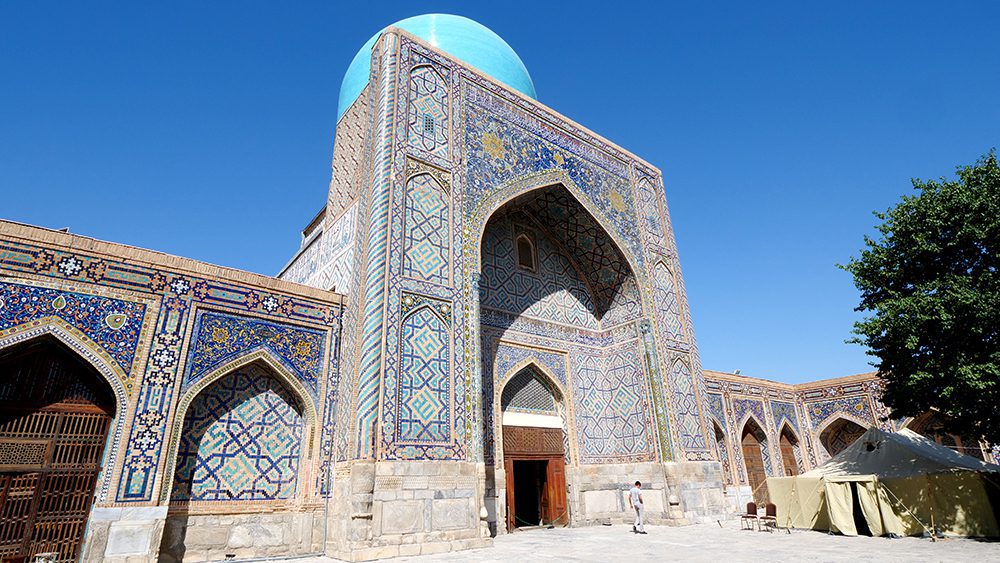
Alexander the Great famously seized the city in 329 B.C. It was later ruled by Iranian and Turk rulers until Genghis Khan took Samarkand in 1220. It was the capital of the Timurid Empire in the 14th and 15th centuries. Along with the rest of Uzbekistan, it became part of the Soviet Union from 1920 until the country gained its independence in 1991. Due to its historical significance, Samarkand was named a UNESCO World Heritage Site in 2001.
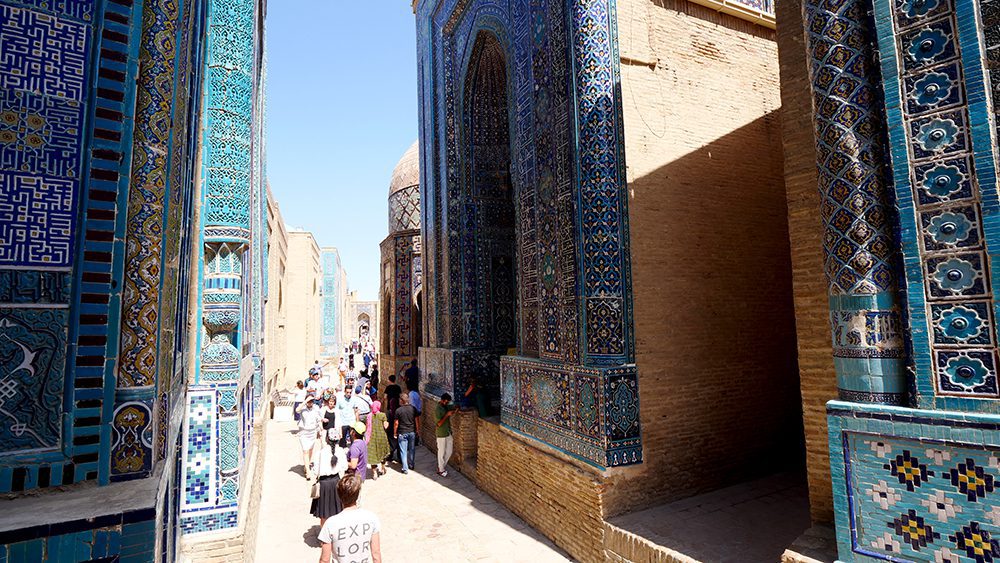
Despite its long and sometimes turbulent history, many things about Samarkand have remained consistent. While the Soviets built a new city that is full of modern administrative buildings, the ancient Old City is also still intact. There, you’ll find historical and cultural sites, restaurants, and handicraft workshops.
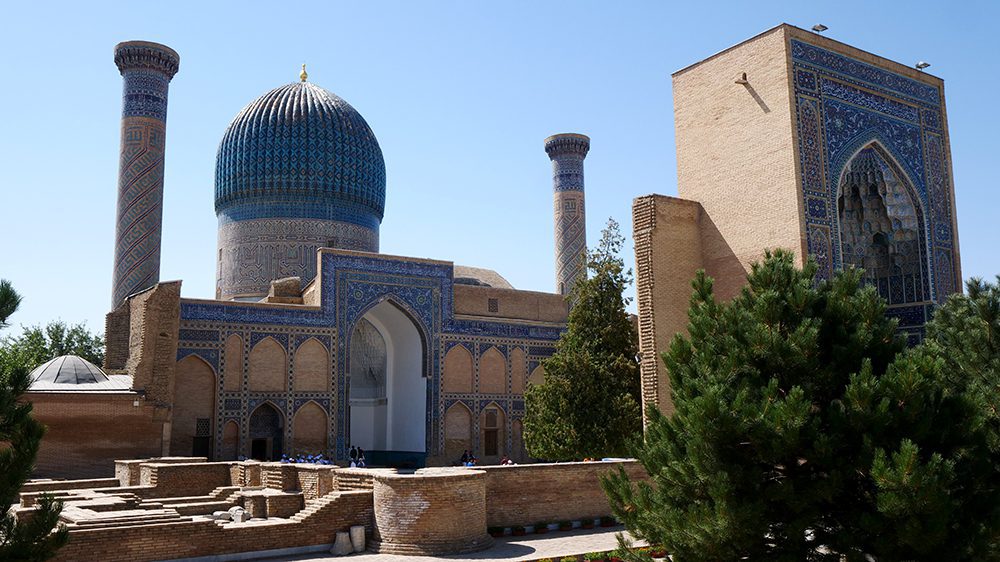
It is at these workshops where ancient, traditional crafts such as woodworking, ceramics, engraving, embroidery, weaving, paper making, and more can be seen in action to this day. Together, these sites make Samarkand a history and culture-lover’s dream to explore! These are the 15 things to see and do in Samarkand, Uzbekistan.
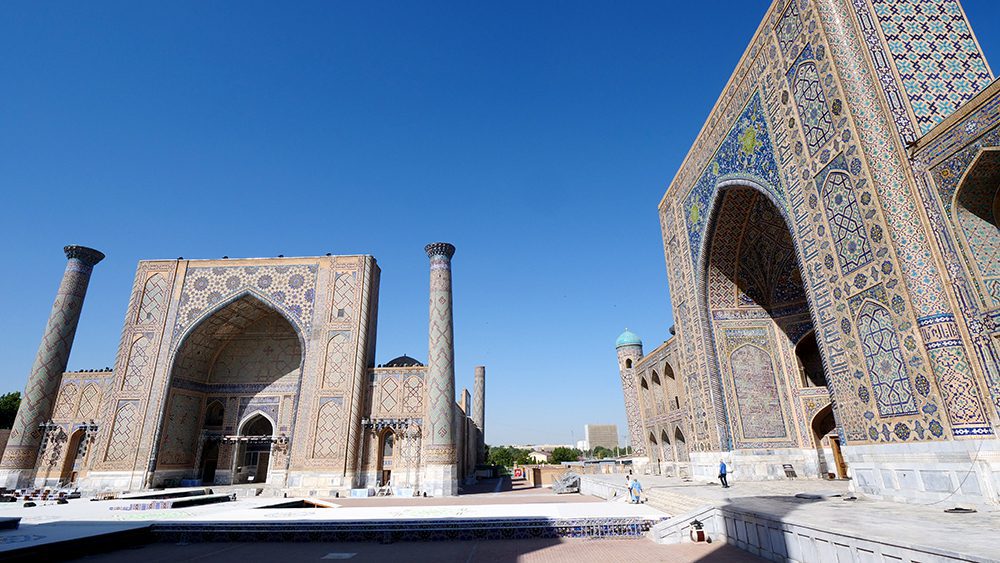
You can’t explore the historical city of Samarkand without visiting its ancient heart, Registan. This gorgeous square served as the site of royal proclamations, as well as public executions. The square is framed by three of the city’s most beautiful and most well-known madrasahs, or Islamic schools.
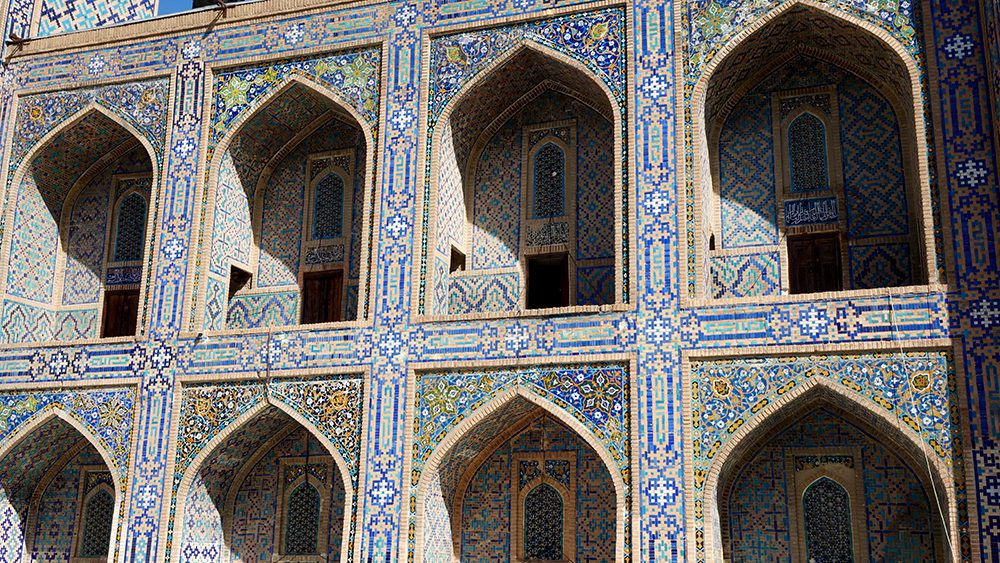
All three—Ulugh Beg Madrasah, Tilya-Kori Madrasah, and Sher-Dor Madrasah—are considered stunning examples of Islamic architecture. I had the pleasure of visiting two of the three during my time in Samarkand!
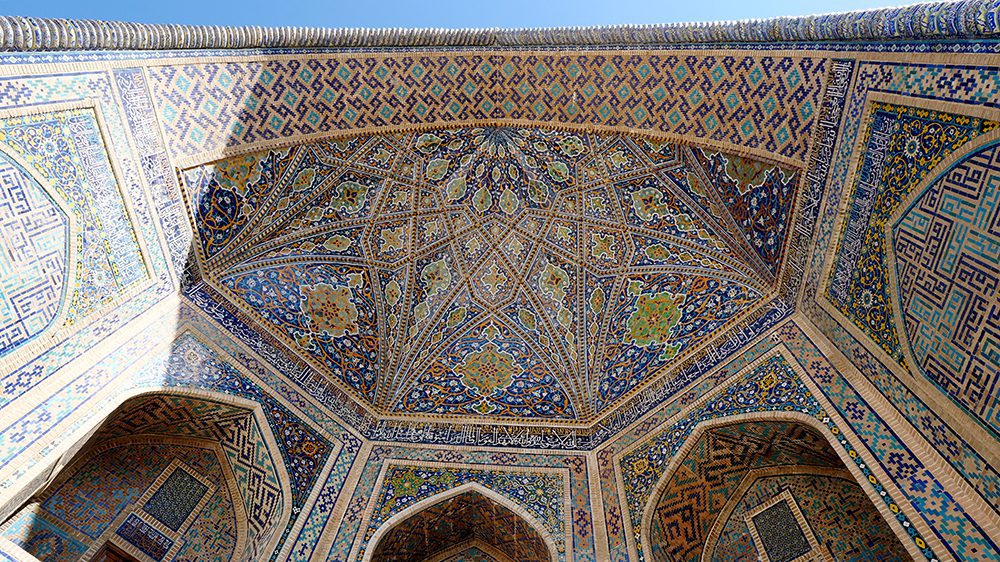
Located on the western side of the square is Tilya-Kori Madrasah. This incredible building was constructed between 1646 and 1660. It is known for its grand façade and massive courtyard. But if you thought the exterior of this historical school was gorgeous, it has nothing on the interior of its turquoise-domed mosque.
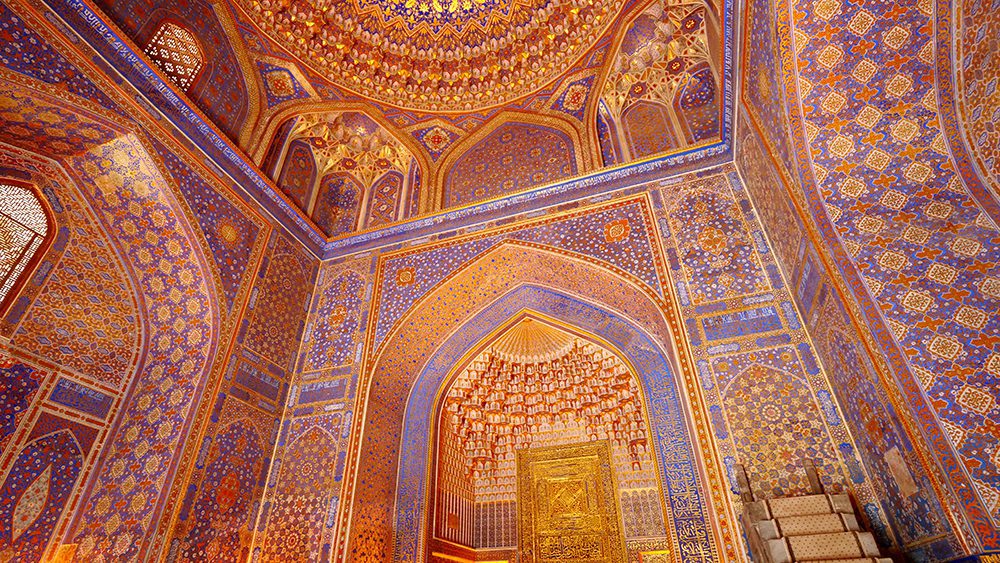
For me, the mosque of this residential college is the real highlight of the Tilya-Kori Madrasah. Because it’s a mosque, remember, you must take off your shoes before you enter. Once you’re inside, you’ll be greeted by colorful, ornate designs on the walls and ceilings.
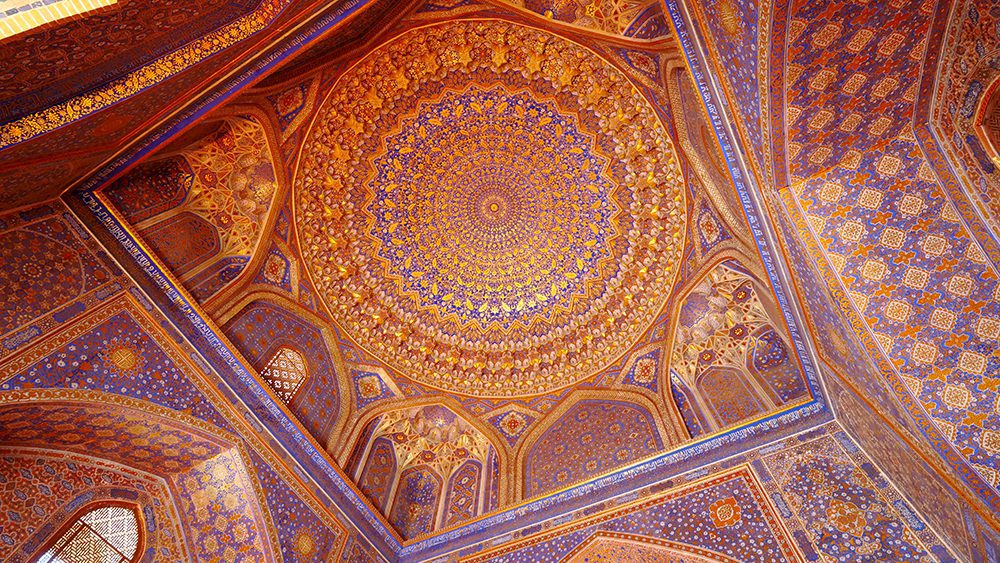
The gold-plated interior, which is accented with a wonderful, rich blue, is an amazing sight to behold. It’s incredibly bright and the designs are incredibly intricate. You’ll even find Arabic scripture from the Koran written in gold on the walls. I couldn’t believe this was a mosque! The sheer beauty took my breath away. If you only have limited time in the city like I did, make sure this mosque is on your list of things to see and do in Samarkand!
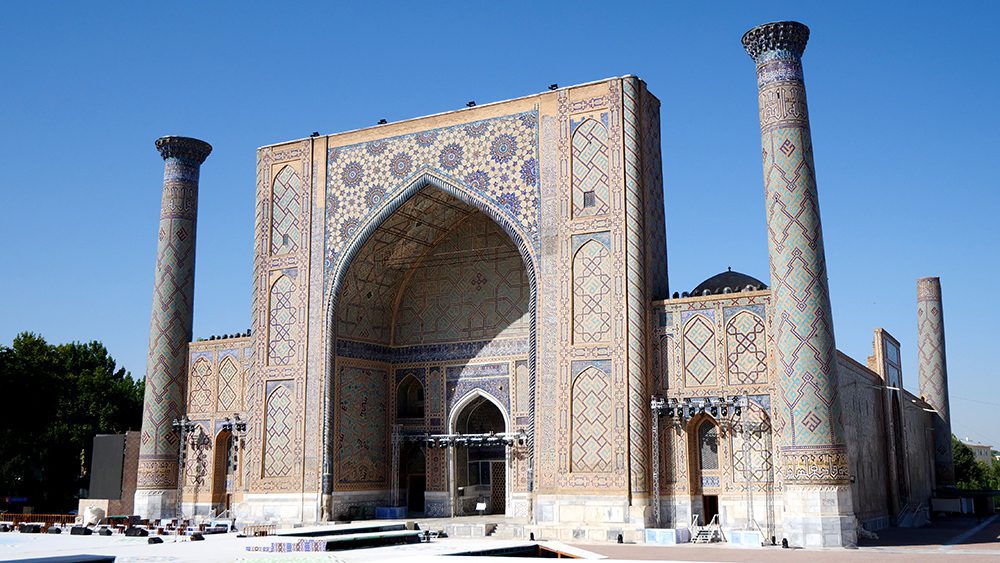
Another of the three madrasahs framing Registan is Ulugh Beg Madrasah, built between 1417 and 1420 by Timurid sultan, astronomer, and mathematician Ulugh Beg. This school is known for its towering iwan, or entrance hall, which is flanked by a pair of imposing minarets. In the 15th century, Ulugh Beg Madrasah was considered one of the best clergy universities in the Muslim world.
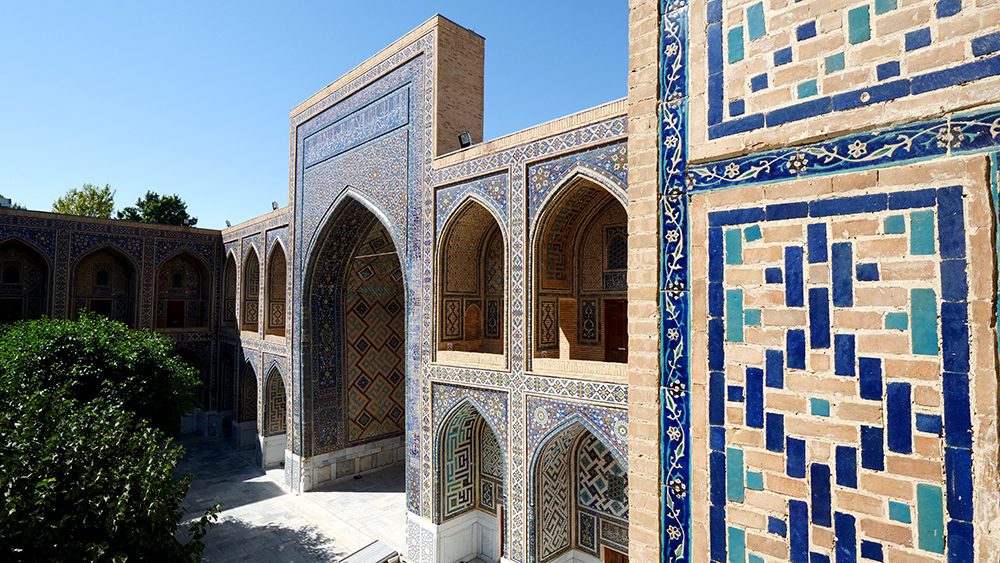
Beyond its iwan and its arched pishtaq, or portal, is a large courtyard that is home to a mosque and lecture rooms. Climb an ancient-looking staircase to the second floor, where you’ll find an open-air walkway along the perimeter of the courtyard. Not only does it boast incredible views of the courtyard below, it’s also located fairly close to the students’ dormitories.
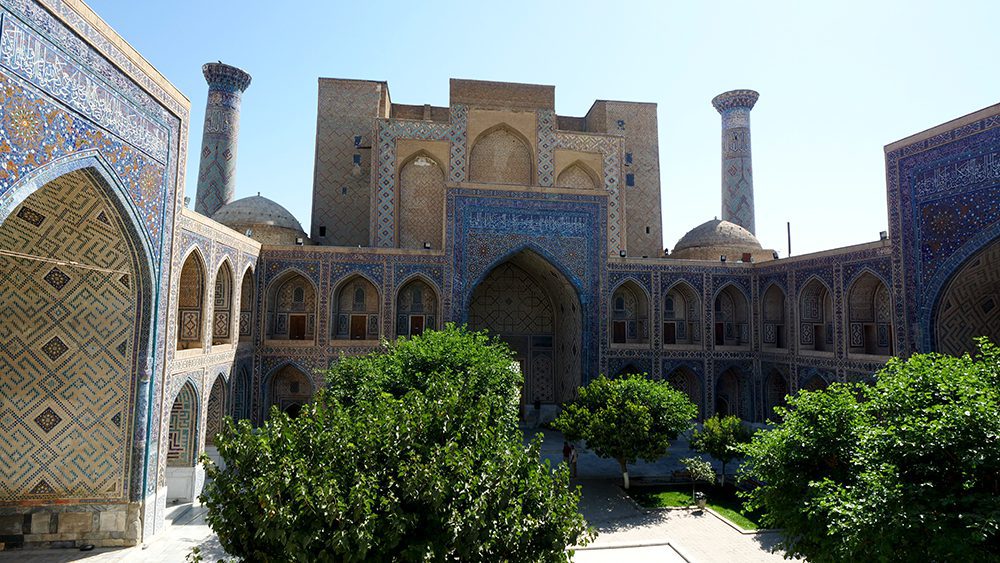
I learned from my guide that the students at Ulugh Beg Madrasah were astronomical and scientific scholars. They arrived at the school having already familiarized themselves with the Koran. After they arrived at the madrasah, they would then choose their field of study. One of Ulugh Beg Madrasah’s students included Abdul Rahman-Jami, a celebrated Persian scientist, philosopher, mystic, poet, and scholar.

The third madrasah of Registan (but the second in the order in which they were built) is Sher-Do Madrasah. Its construction was commissioned by Yalangtush Bakhodur, the ruler of Samarkand, and spanned 17 years between 1619 and 1636.
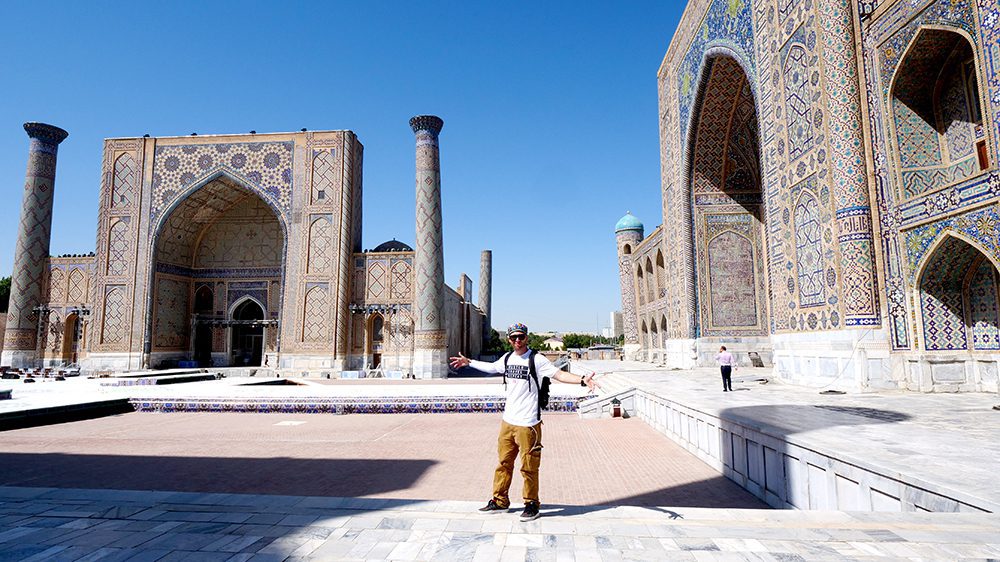
This madrasah’s appearance is considered subversive to some, as its famous tiger mosaics on its façade go against Islamic rules that ban images of living beings on religious buildings. This act of subversion makes seeing the exterior of Sher-Do Madrasah one of the most interesting things to see and do in Samarkand!
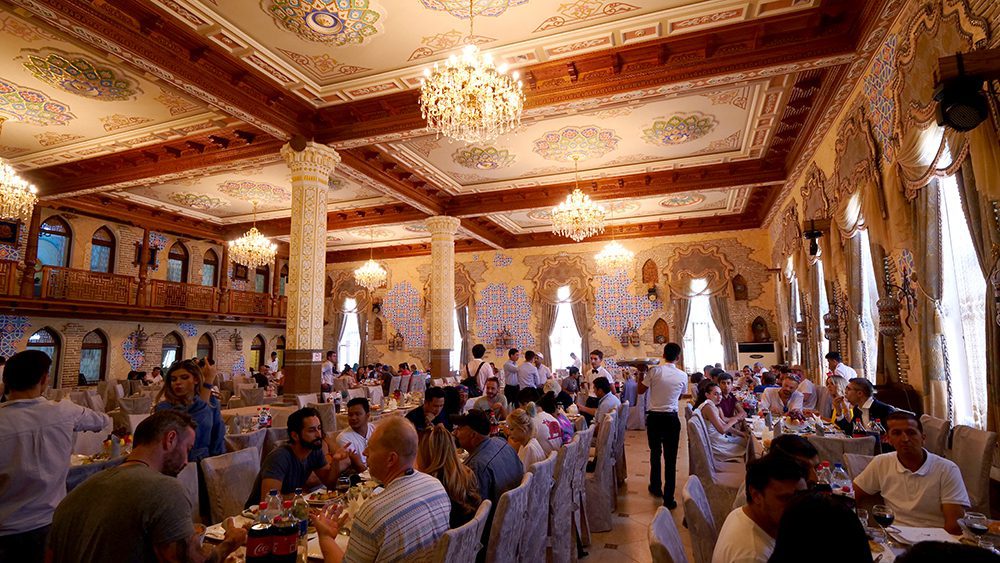
As I mentioned earlier, Samarkand has quite a few delicious food offerings, and some of my favorites can be found at its eponymous restaurant, Samarkand Restaurant. This eatery along Makhmud Kashgary Street boasts an enormous dining hall and high ceilings that looked to be at least 20 feet high.
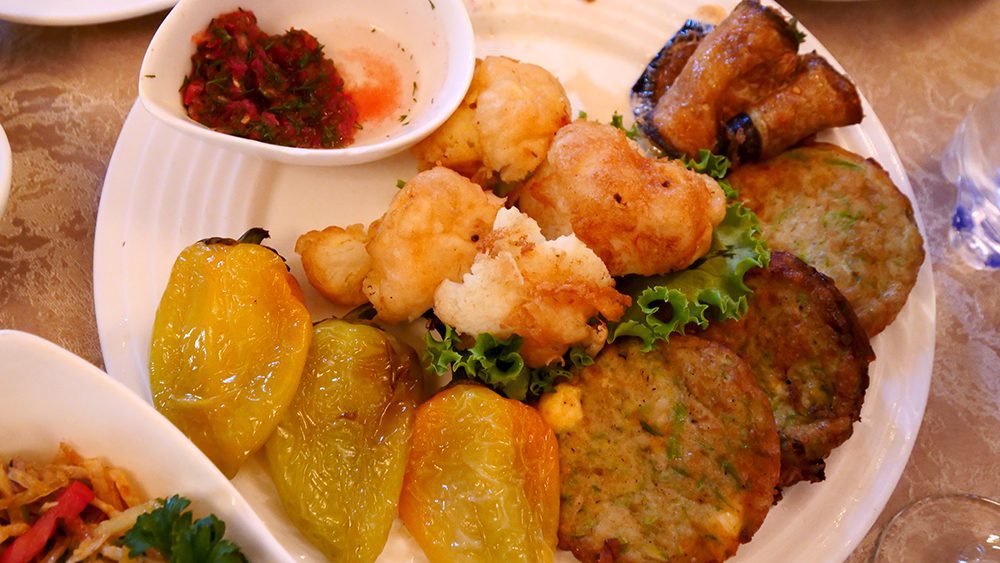
There are several mouthwatering salads and appetizers on the menu, including a moist and crunchy stuffed zucchini. I also recommend trying the wonderful omelet-like fritter made from eggs and vegetables. The fresh and tasty ham salad with peas and potatoes is very nice, as is the fried cauliflower. I suggest trying a pepper, which is juicy and refreshing and contains no spice whatsoever.

But you can’t beat Uzbek tomatoes, which are some of the freshest, juiciest, and most flavor-packed I’ve ever eaten in my life. You’ll find them in a yummy salad with olives and cottage cheese. It’s similar to a Greek salad and is the perfect thing to whet your appetite before the main course.
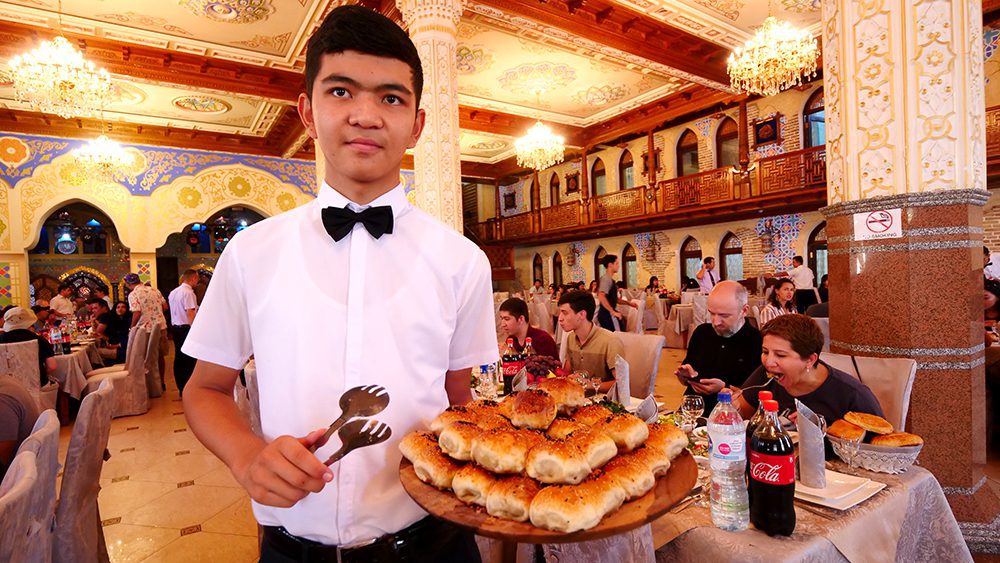
Even if you’ve tried somsas in other parts of Uzbekistan, make sure you try one at Samarkand Restaurant. The somsas here are round instead of the usual teardrop shape you’ll find in other cities, and are both fluffier and denser. The dough is crisp and airy, while the filling is made up of tasty, tender meat and onions.
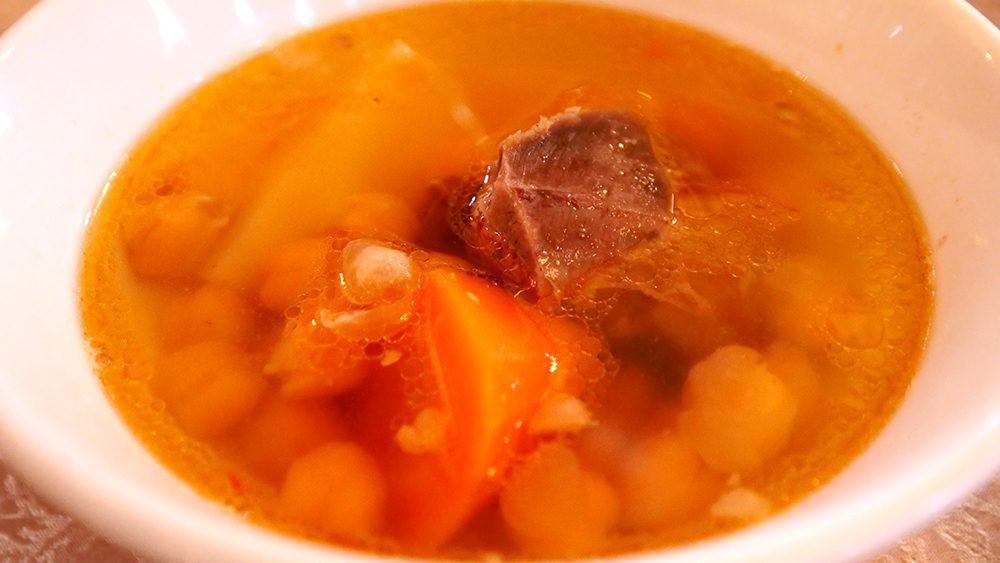
Don’t miss the Nohot Shurva, which is a soup that contains carrots, chickpeas, and potatoes, as well as a massive piece of beef. The broth is full of nice, complex flavors that soak into the chickpeas! The carrots add a bit of sweetness, and the buttery, tender beef has to be tasted to be believed!
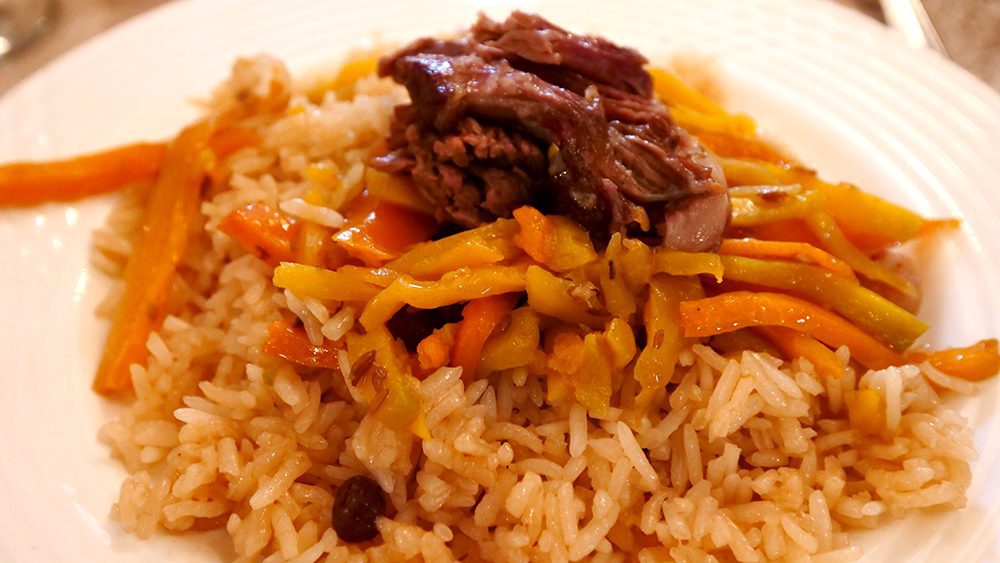
Speaking of sweet carrots, the main dish you must have at Samarkand Restaurant is the plov. Plov is the national dish of Uzbekistan and has many regional variations. The kind served here is made with brown rice, which has a slightly more nutty flavor.
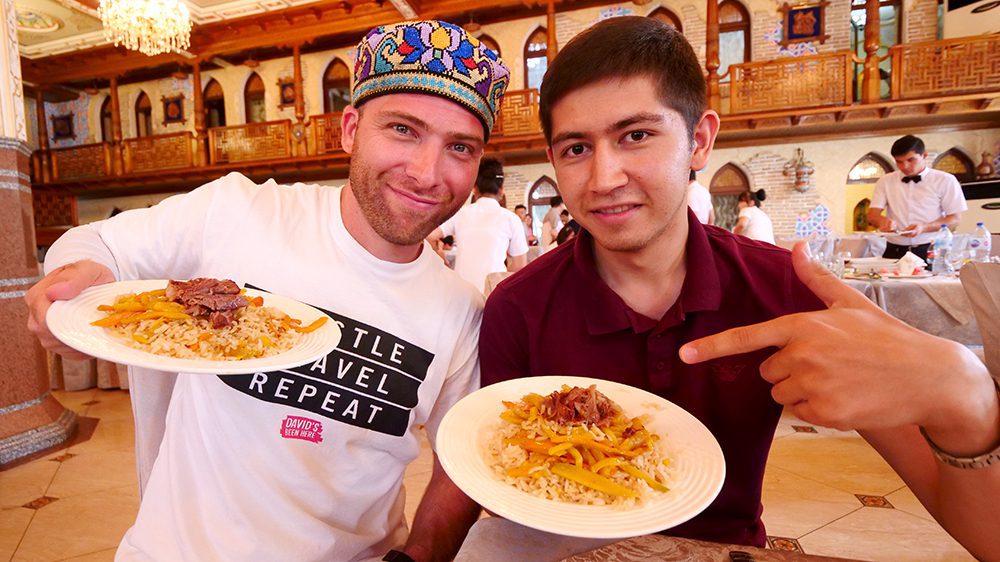
Another difference between this plov and other variations I’d tried is that the carrots were placed on top of the rice instead of mixed throughout. Chickpeas, raisins, and beef were mixed throughout. The raisins, carrots, and oil in the dish perfectly complemented one another and added a sweet, fruity flavor that made it irresistible!
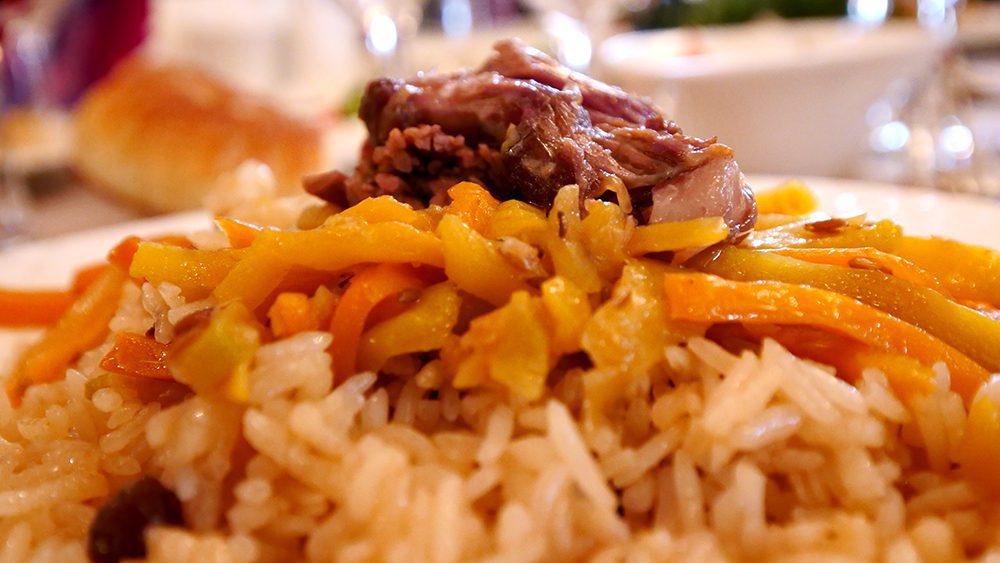
Round out your meal with a Bagizagan Select 2009 Merlot. It’s young, fresh, and fruity, and pairs extremely well with the food!
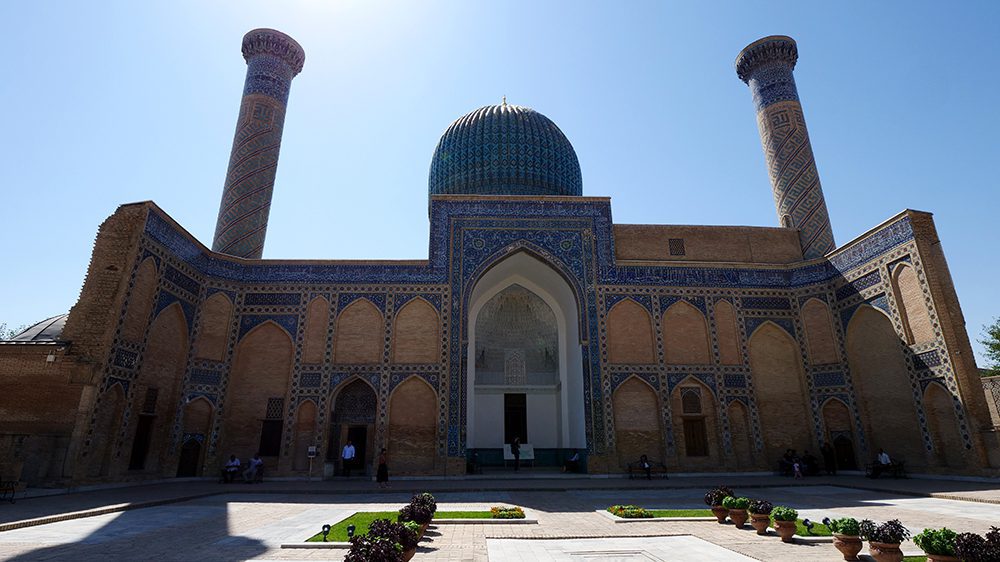
You can’t truly understand a new location without taking a dive into its history. When you start studying Uzbek history, the name Amir Timur seems to pop up more than any other. Amir Timur was a Turco-Mongol conquerer who founded the Timurid Empire in 1370. The empire stretched from India to Syria, and included Iran, the Fertile Crescent, Afghanistan, Turkey, and Uzbekistan. As an undefeated commander, Timur is considered one of the greatest military leaders in history. That said, his empire began to fracture soon after his death in 1405.
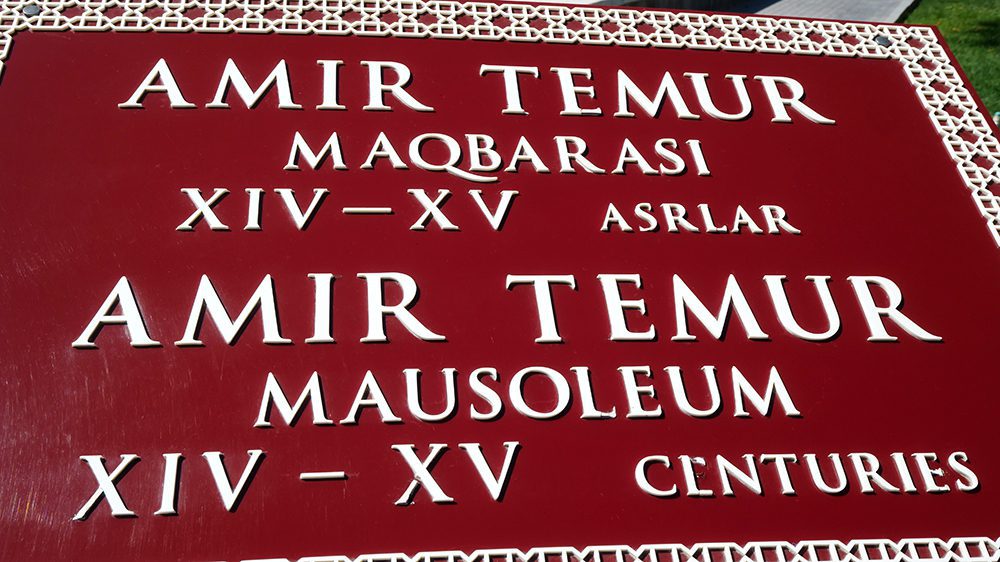
Timur is buried at his mausoleum, known as Gur-e-Amir, in Samarkand. It’s a shining example of Persian-Mongolian architecture and served as a precursor of sorts for Mughal tombs. Other famous structures built in that style include Humayun’s Tomb in Delhi and Agra’s famed Taj Mahal. This was one of my favorite things to see and do in Samarkand and should be on every itinerary!
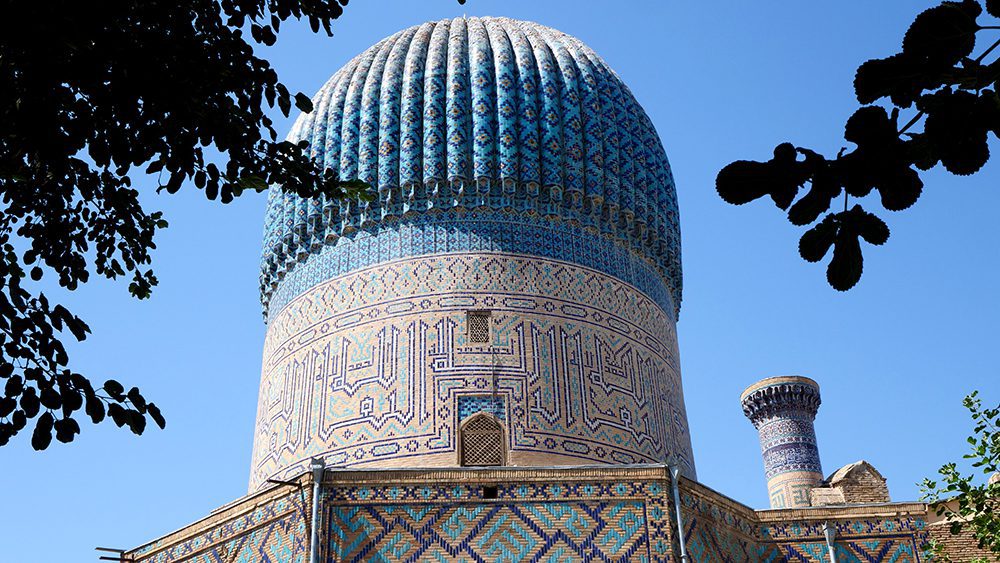
It only costs 1,000 som ($0.10 USD) for Uzbek residents to enter the tomb. But foreigners will pay 25 times more at 25,000 som ($2.63 USD). It’s well worth the cost of admission, though. You can view a several-hundred-year-old irrigation system and two minarets in the complex’s beautiful courtyard. The exterior of the tomb didn’t look finished to me, or like part of it had been destroyed. I later learned that there was once an old madrasah on the site, but only its foundation remains today.

Timur and the most important figures in his life, including his spiritual teacher, are buried in the tomb. It’s a large, opulent building that serves as a testament to Timur’s power while he was alive. During my visit, I was struck by the tomb’s symmetry and grandeur. It’s a beautiful, breathtaking place meant to honor one of the world’s greatest military minds.
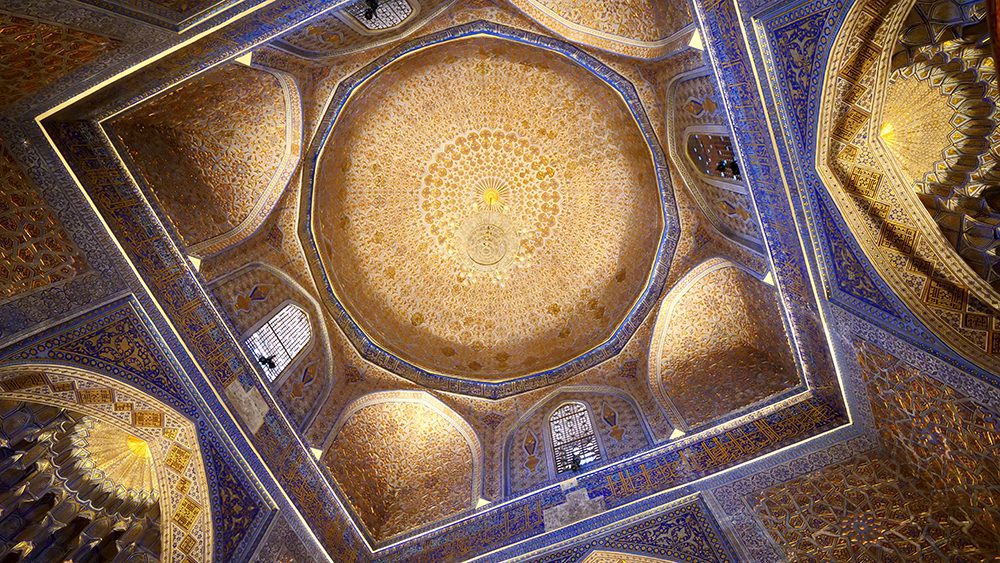
Most curiously, though, there is a grave belonging to an unknown person inside the tomb as well. No one knows who this person could be or why their final resting place is there among Timur and those who were closest to him. At the back of the tomb, you’ll find the crypt, which is only accessible for VIPs.
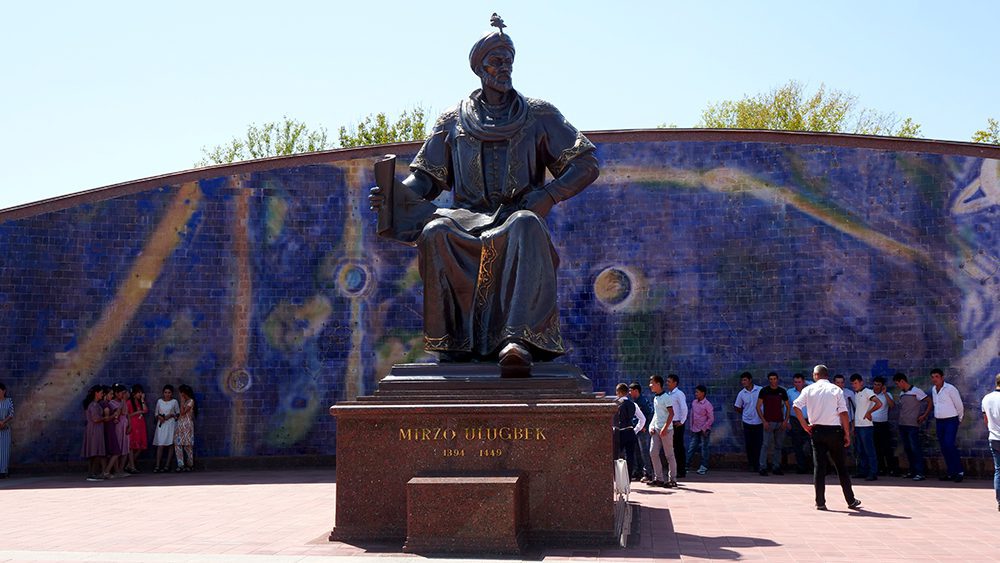
Another fantastic historical site where you can explore Samarkand’s rich past is the Ulugh Beg Observatory. It is thought by many that its construction of its foundation began around the year 830 AD, but it wasn’t completed until nearly 600 years later. Built by the Timurid astronomer and mathematician Mirzo Ulugh Beg in the 1420s, it was considered one of the finest and most important observatories in the Islamic world.
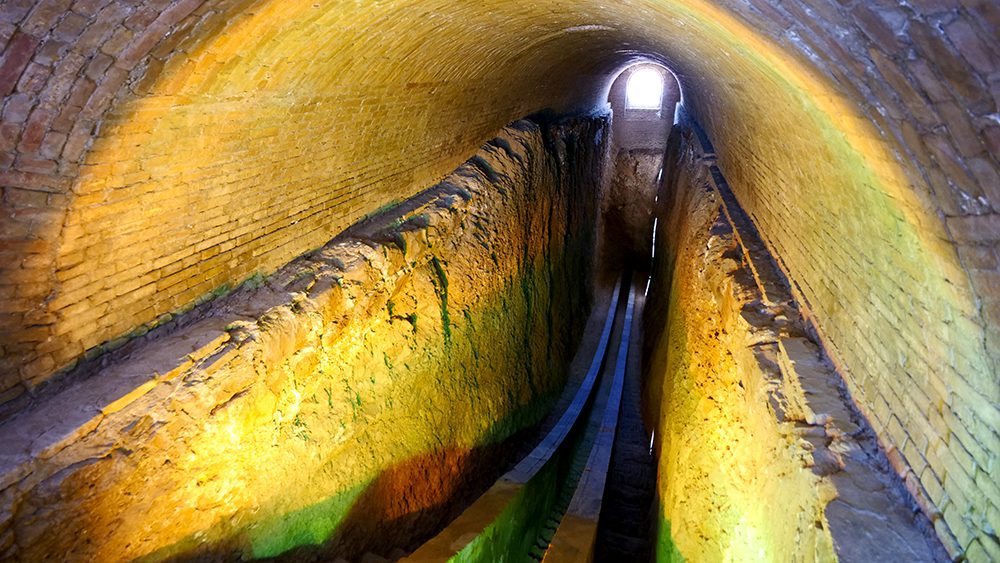
Mirzo Ulugh Beg invited numerous noted astronomers and mathematicians to help build and work at the observatory. The observatory was destroyed sometime after Ulugh Beg’s death in 1449, but its remains were discovered in 1908. Today, you can explore the observatory and see where Ulugh Beg and his colleagues did their research and viewed the stars. Checking out the site gives visitors a captivating look not only into the history of Samarkand, but also the sciences they practiced.

Near the observatory is the equally fascinating Complex Museum of Mirzo Ulugbek. Inside, you can learn more about this Uzbek scholar and view replicas of his work, including star charts and the Zij-i Sultani astronomical table and star catalogue. Visitors can also see paintings of him and his colleagues, miniature models, and 15th-century astronomical instruments like astrolabes. There is even a miniature model of the Ulugh Beg Observatory there!
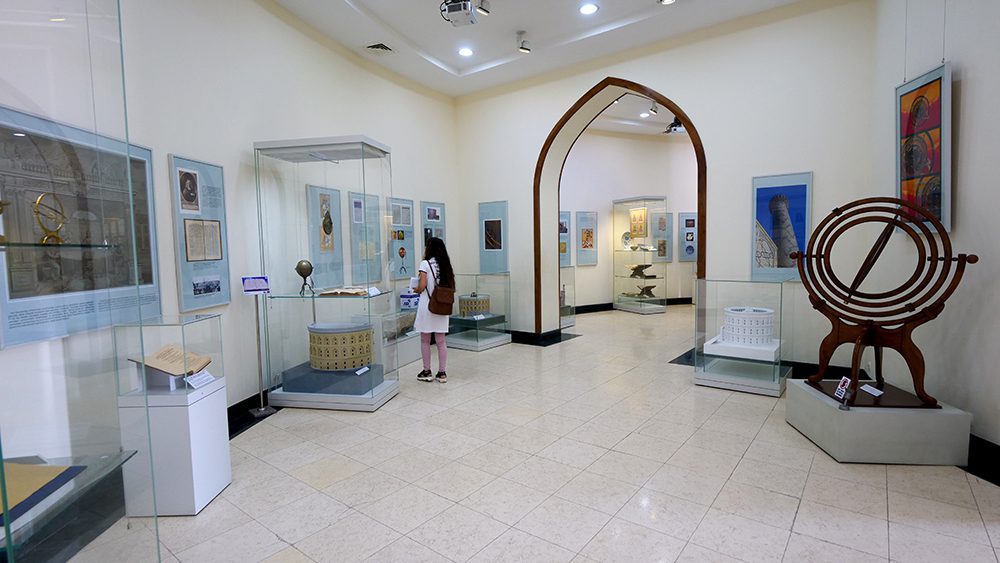
If you’re into both history and science, visiting the observatory and museum is easily one of the top things to see and do in Samarkand!
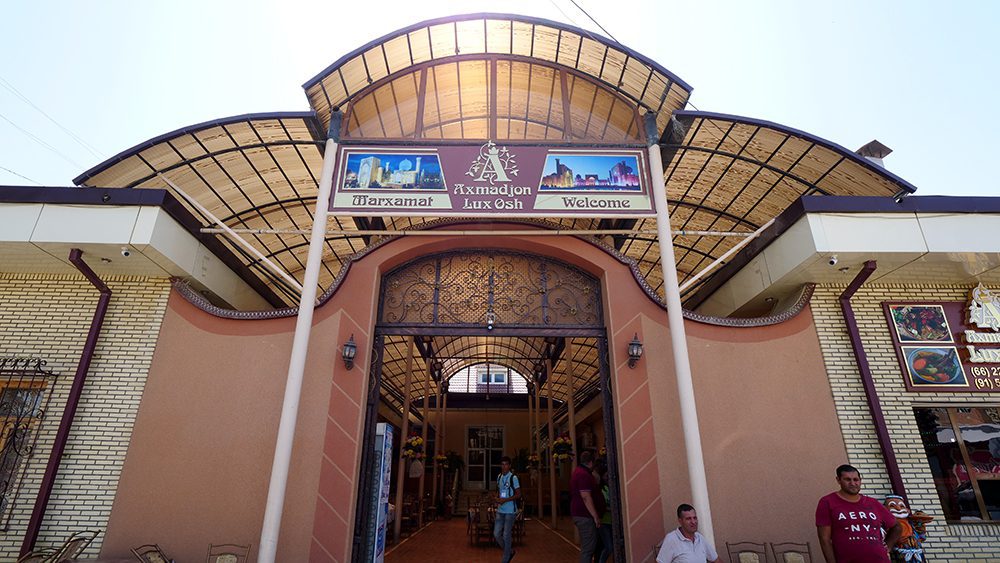
I mentioned plov earlier when I talked about Samarkand Restaurant. But I must mention it again here because the kind offered at Axmadjon Lux Osh Restaurant is too good to pass up. The chefs there are masters at preparing massive servings of this Uzbek rice dish. Not only is the plov huge, it lived up to everything I had heard about this restaurant. I had heard it was the place to visit if you wanted to try Samarkand’s best plov.
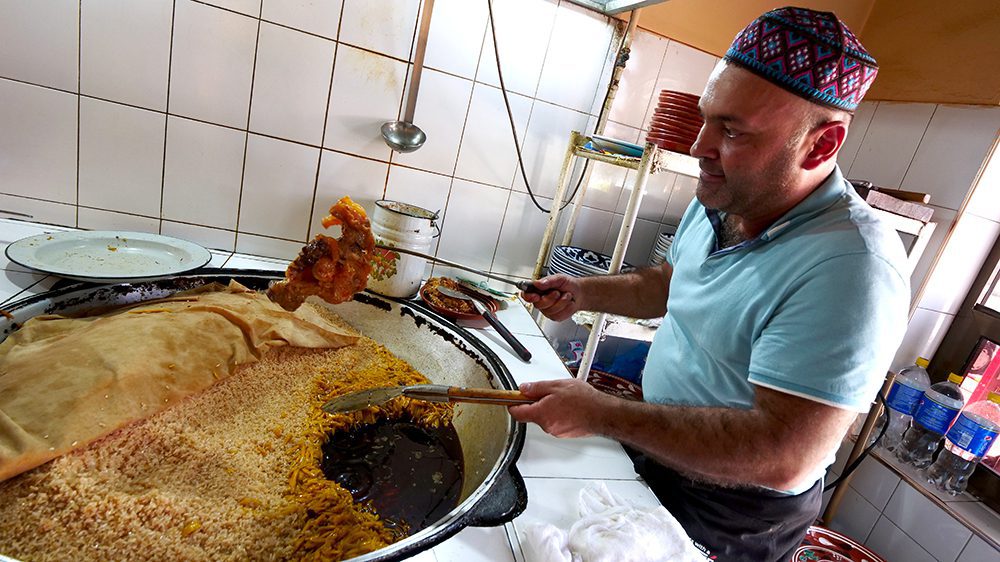
Like the variety at Samarkand Restaurant, this is a Samarkand-style plov. The carrots are served on top of the rice instead of mixed in it. The plov is also topped with tender beef. Unlike other plovs I’d had, this one contained small and juicy baby chickens. It also came with gamy horse meat sausage and tiny quail eggs. You also get chickpeas and cucumber, as well as a large and flavorful piece of fat.

The plov is presented in a large serving dish. This outstanding rice dish is massive, but don’t neglect the items on the side. They include soft Uzbek bread, tomato salad, yogurt, and a creamy and minty yogurt drink.

Alone, the plov is heavenly. The combination of the oil, rice, carrots, and chickpeas had me salivating from the very first bite! The horse sausage adds a nice, gamy wildness to the dish, and the quail egg was a tasty addition as well.

The inside of the baby chick was like ultra-tender minced chicken. It added something new to the plov, as this was the first variety I’d had on my trip that included chicken meat. The best thing about the plov is that it’s totally different from other rice dishes I’d eaten around the world, like biryani, paella, and pulao. It’s its own thing and is outstanding!
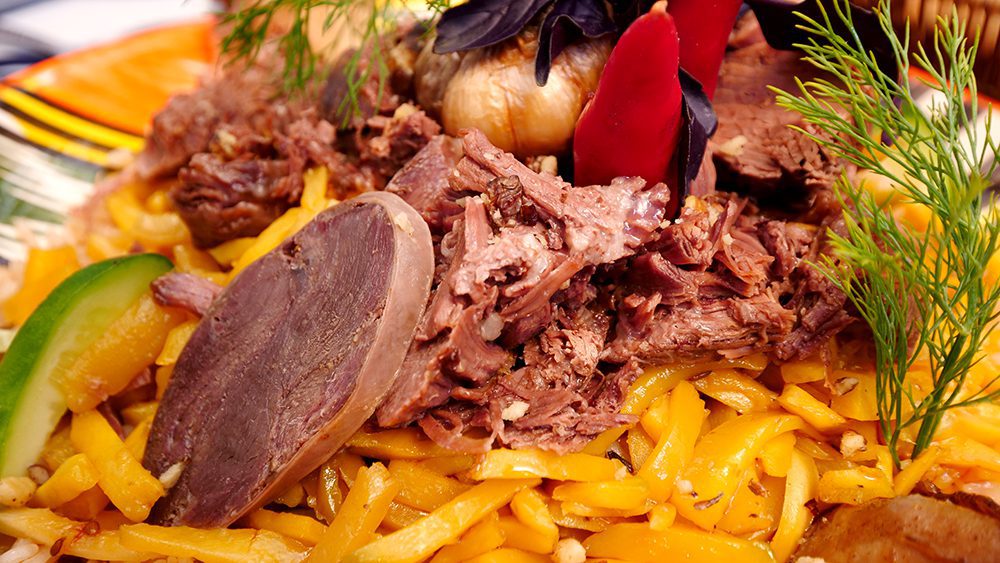
For an added burst of flavor and a creamy texture, try the plov with a dollop of the yogurt, and if you’re brave enough, mix in one of the spicy red peppers they provide! Break up the heaviness and oiliness of the dish with the tomato, onion, and cucumber salad that’s served on the side, and don’t forget the vodka! Trying some is one of the best things to see and do in Samarkand. Look out, though…it’s strong!
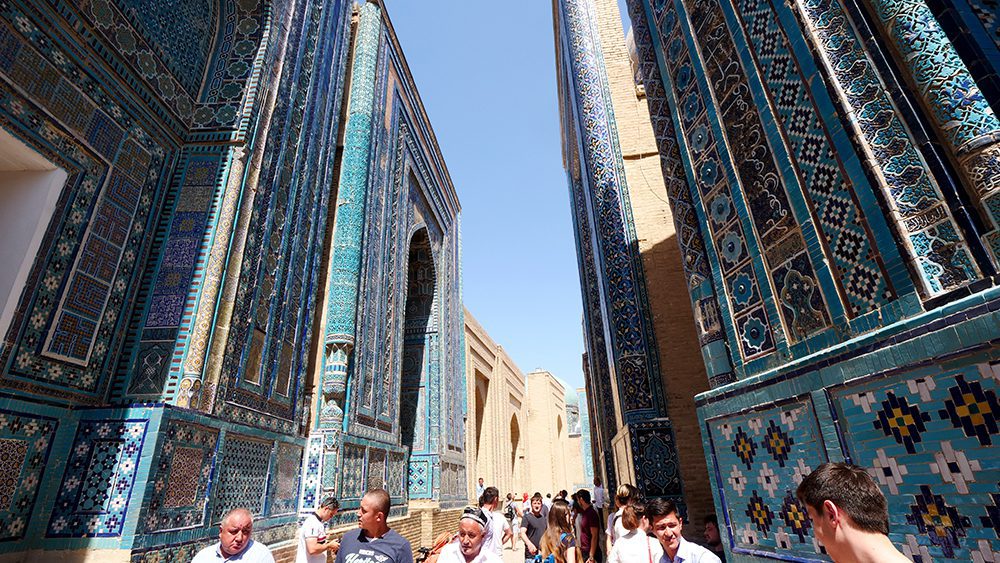
No tour of Samarkand’s historical sites is complete without a visit to Shah-i-Zinda, a beautiful necropolis complex in the northeastern part of town. The complex is comprised of over twenty buildings, including temples and eleven mausoleums, most of which were constructed between the 11th and 19th centuries.
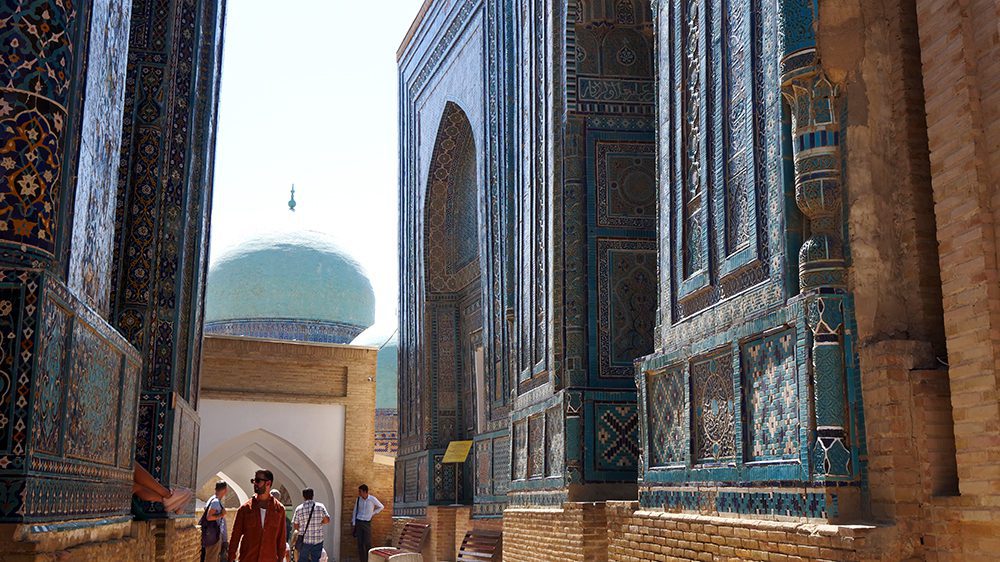
The main body of the necropolis is known as the Kusam ibn Abbas Complex, which was constructed between the 11th and 13th centuries. It’s named after a cousin of the prophet Muhammad who is credited with bringing Islam to what is now Uzbekistan. His complex is made up of several buildings, including his colorful mausoleum, a 16th-century mosque, and a prey room.
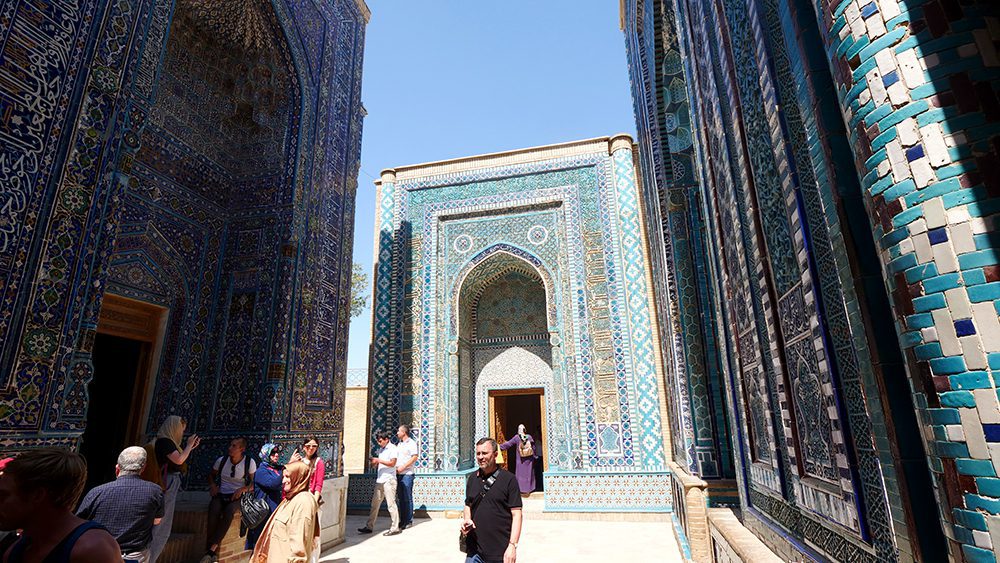
In addition to Kusam ibn Abbas, the necropolis is also the final resting place of many other notable historical figures. Scientist and astronomer Kazi Zade Rumi was laid to rest in a 15th-century mausoleum near the complex’s multi-step staircase. Shadi Mulk Aga, the niece of Amir Timur, has a mausoleum on the western side of the complex, while Timur’s sister, Shirin Bika Aga, was buried in the mausoleum across from hers.
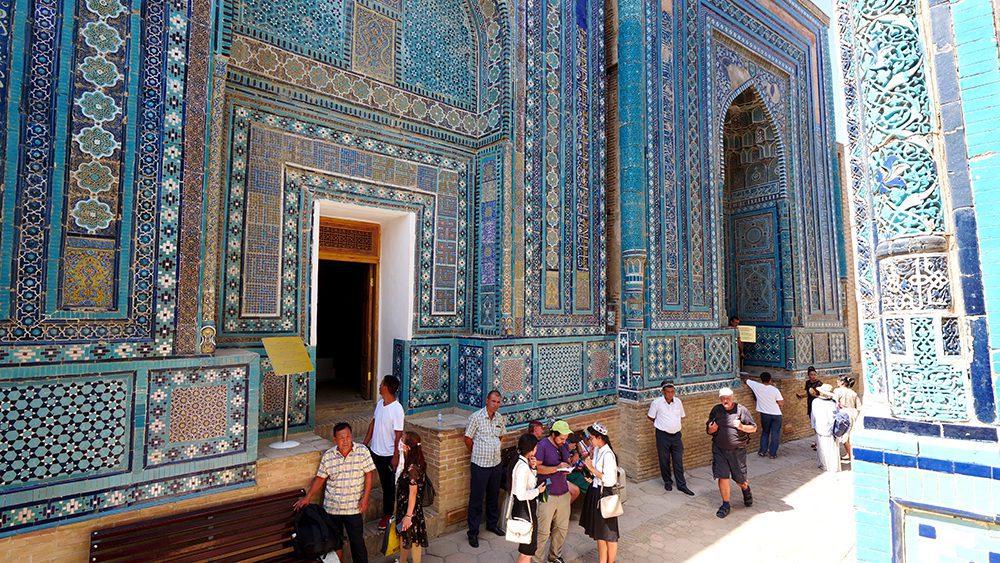
I was blown away by the size and beauty of the complex. The grandeur of the mausoleums was yet another indication of how powerful Samarkand was. Equally impressive is the fact that the colorful and intricate tile work on the mausoleums has remained intact for seven centuries! Visiting them is one of the top things to see and do in Samarkand, especially if you want to learn more about the notable figures in its history!
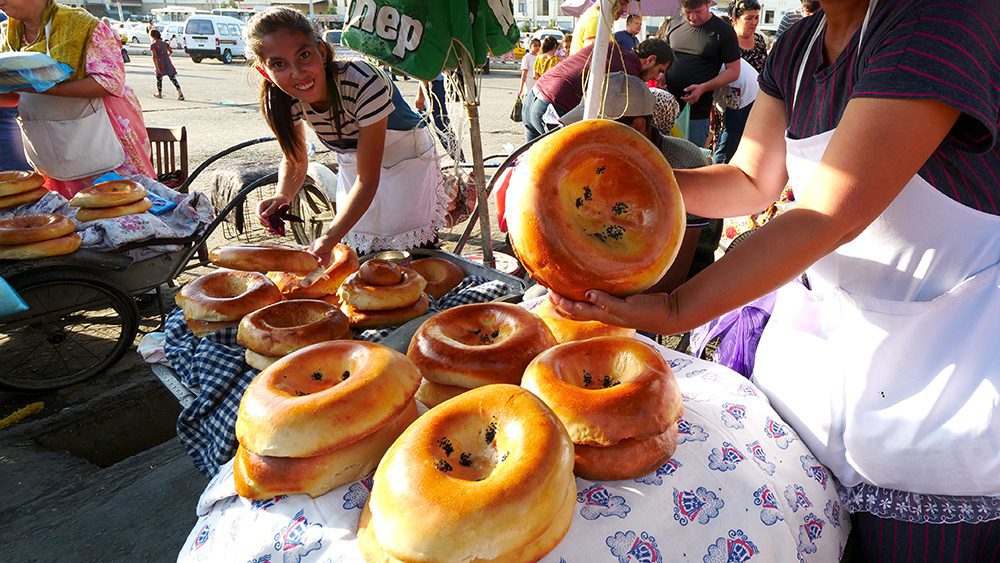
To get a glimpse into daily life in Samarkand, one of the best places to check out is the city’s biggest bazaar, Siyob Bazaar. This bazaar located next to Bibi-Khanym Mosque serves as an all-purpose market where vendors sell everything from fresh produce to sweets to household items. If you like getting a peek at local life when you travel, visiting Siyob Bazaar is one of the best things to see and do in Samarkand.
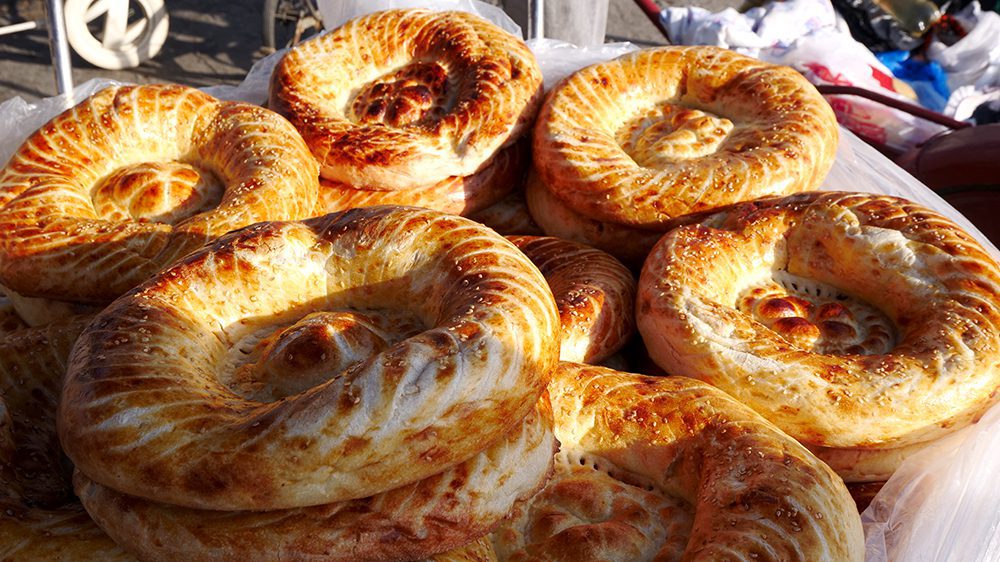
Immediately upon entering Siyob Bazaar, I came across vendors selling fresh, juicy watermelon and buttery Samarkand naan. This delicious-looking bread is noted for its round shape and the deep indentation in its center, which sometimes contains black sesame seeds. You can also buy freshly-prepared vegetable dishes, corn on the cob, and more.
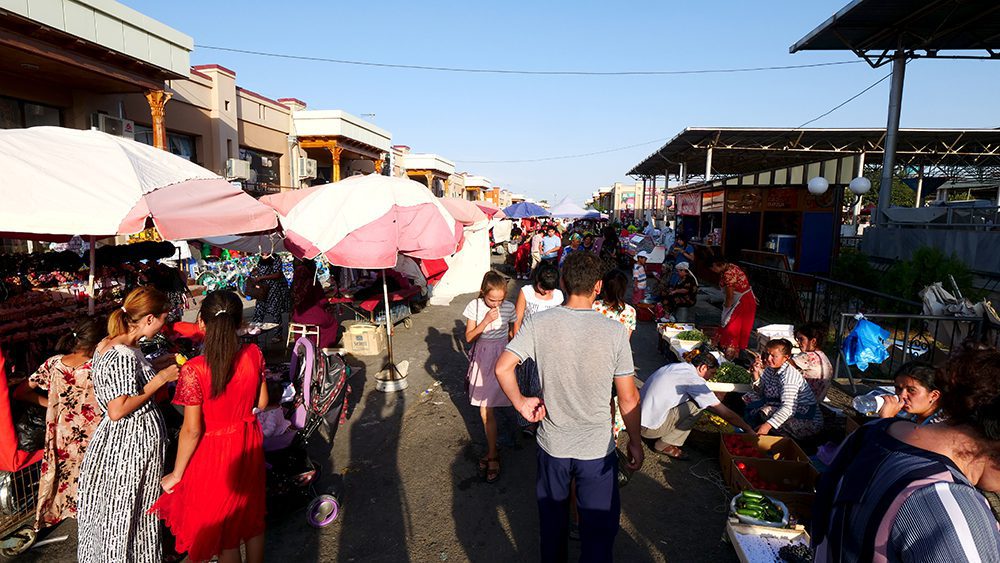
Further on in the market, you’ll come across friendly vendors who will happily let you sample their produce, whether it’s fresh figs, grapes, or blackberries. The older woman who sells the blackberries also squeezes fresh blackberry juice, which tastes incredibly sweet and pure.
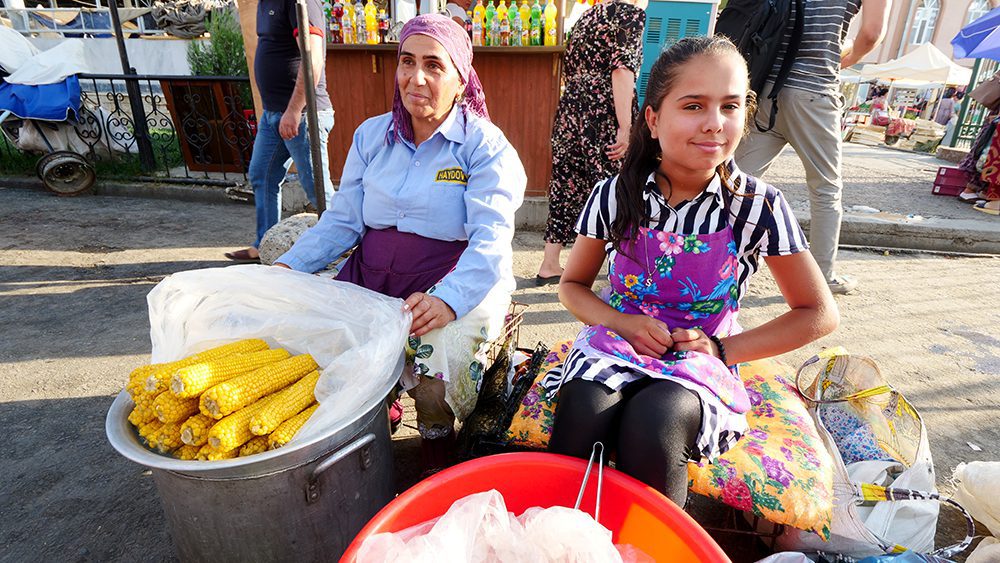
As you continue through the labyrinthine paths of the bazaar, you’ll see vendors selling newspapers and household items like buckets and storage containers. There are even clothing vendors. I bought a beautiful, hand-knitted hat from a very kind woman for 50,000 som, or roughly $5 USD.
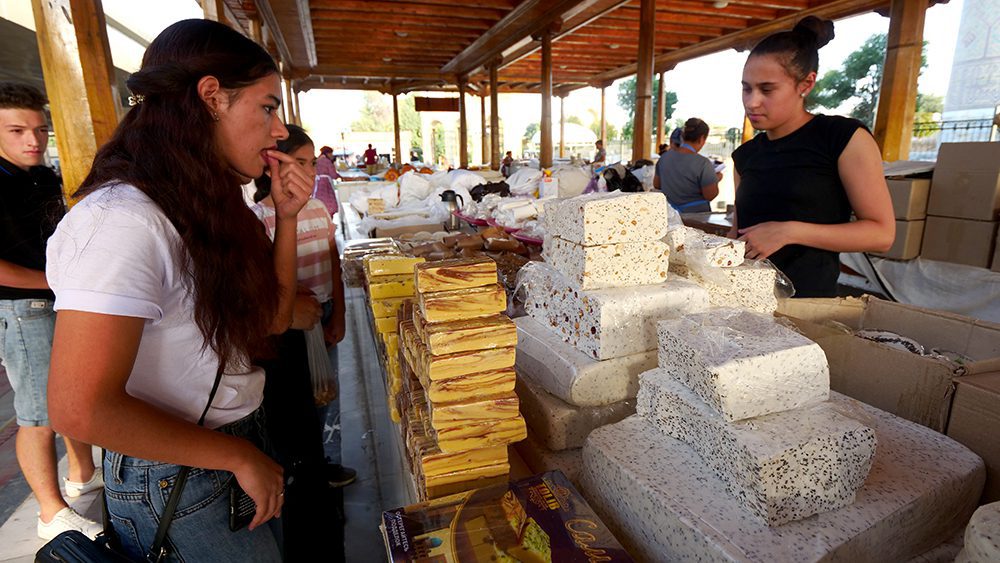
If you’re into sweets, Siyob Bazaar is the place for you. As you head deeper into the bazaar, you’ll find yourself in a section entirely dedicated to sweet Uzbek confections. There, you’ll find everything from rock candy to sweet wedding bread to a halwa-like sweet made from yogurt.
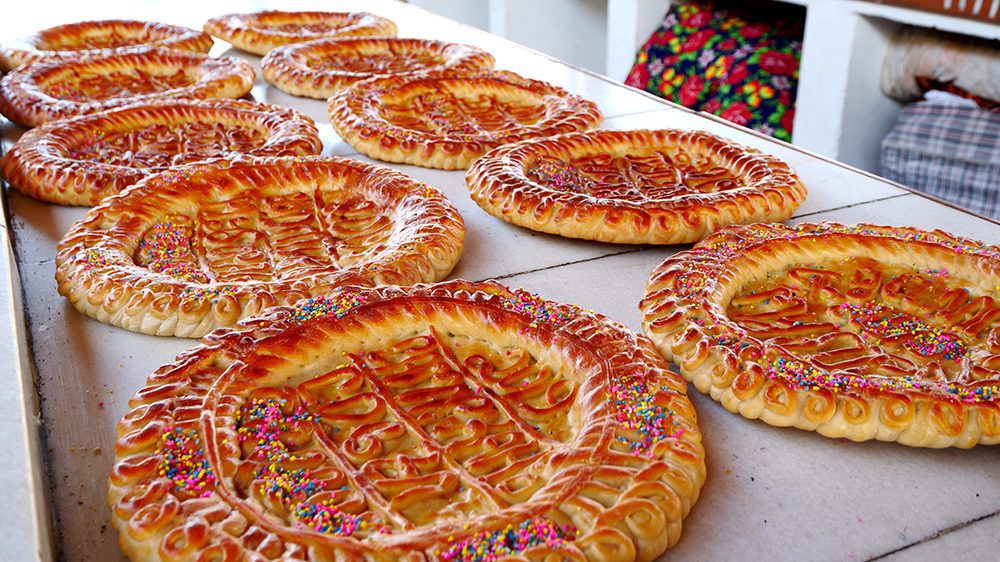
In addition to shopping, Siyob Bazaar is also a fantastic place to people watch. Observing the locals shop and interact with the vendors is a great way to get a feel for what Samarkand is really like. Just be aware that while the vendors I came across were very nice, many of them did not want to be on camera. Keep that in mind if you go to the bazaar looking to film your adventures and you should have as wonderful of a time as I did!
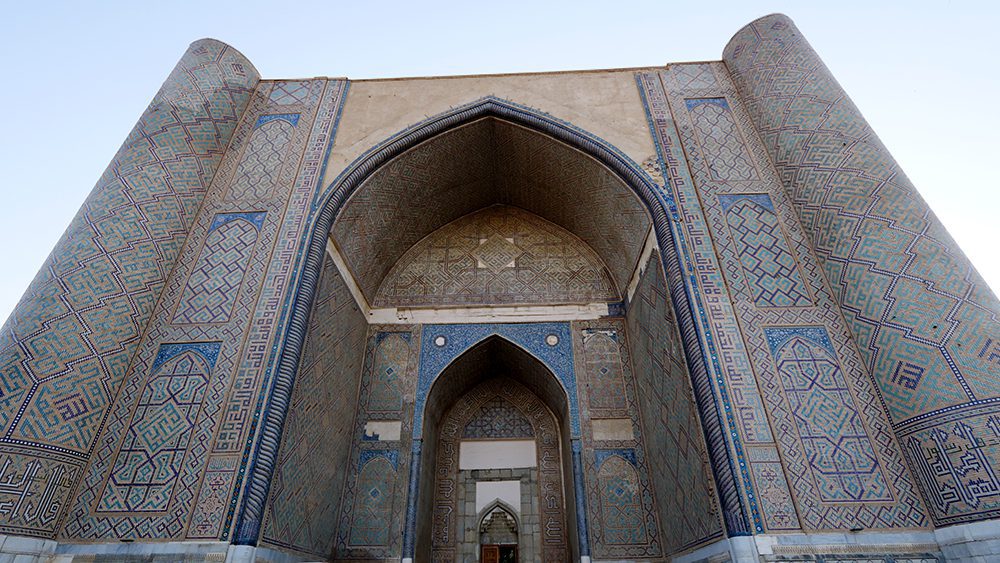
From Siyob Bazaar, you only need to take a few hundred steps to the next item on our list of things to see and do in Samarkand, Bibi-Khanym Mosque. This enormous Islamic house of worship was built between 1399 and 1444 and, for a time, was the biggest mosque in Central Asia. It is said that 95 elephants were used to assist in its construction!
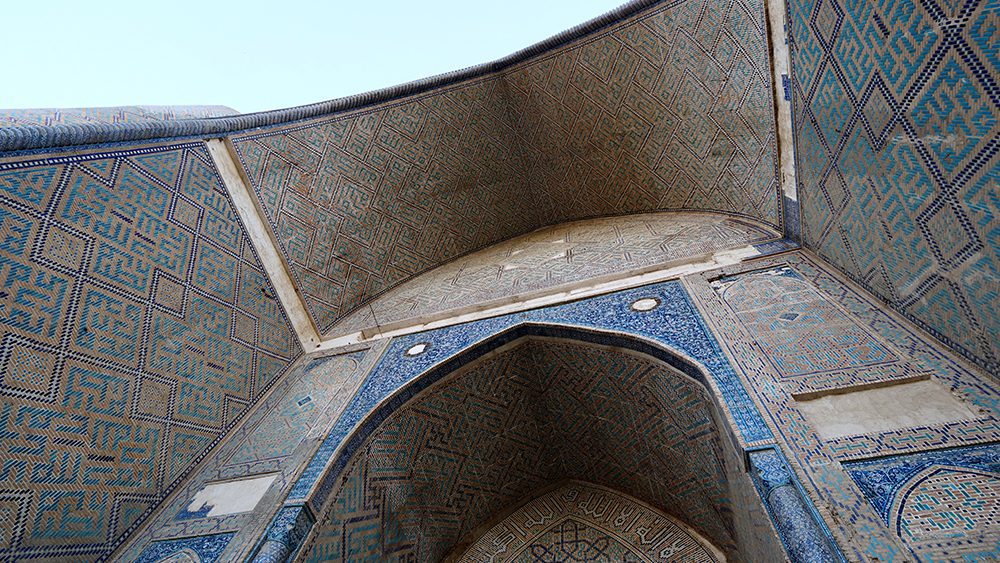
Construction of the mosque was commissioned by Amir Timur, who wanted to have a massive mosque in Samarkand, his empire’s new capital. However, construction on Bibi-Khanym Mosque was rushed, and therefore, its structural integrity was compromised. The mosque had to be reconstructed and reinforced several times throughout its history, including as recently as 2016.
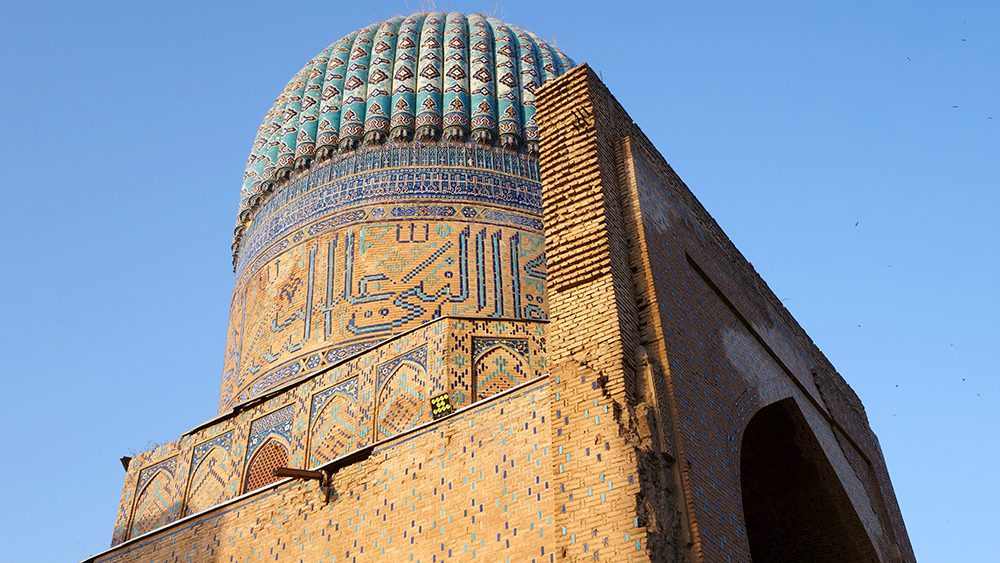
The mosque’s outer walls encircle a rectangular courtyard, at the center of which is a large, marble pedestal that serves as a Koran stand. Other features of the mosque include four minarets at each of the sites outer corners and four more minarets flanking the entrance’s portal arch.
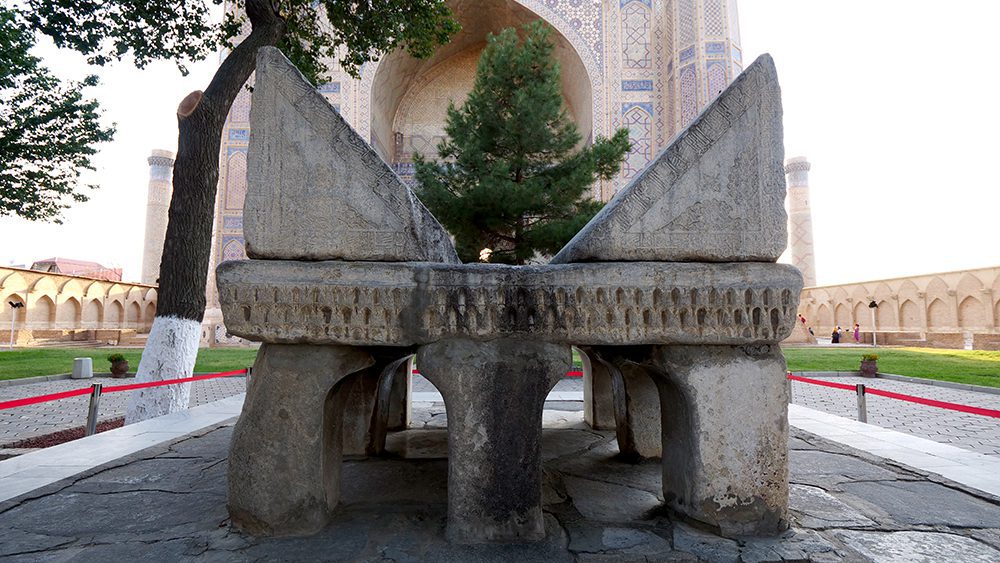
Despite its early structural problems, the entire building is an aesthetic masterpiece. It’s stunning to look at and it’s easy to feel small when you’re standing in the shadow of its massive gate.
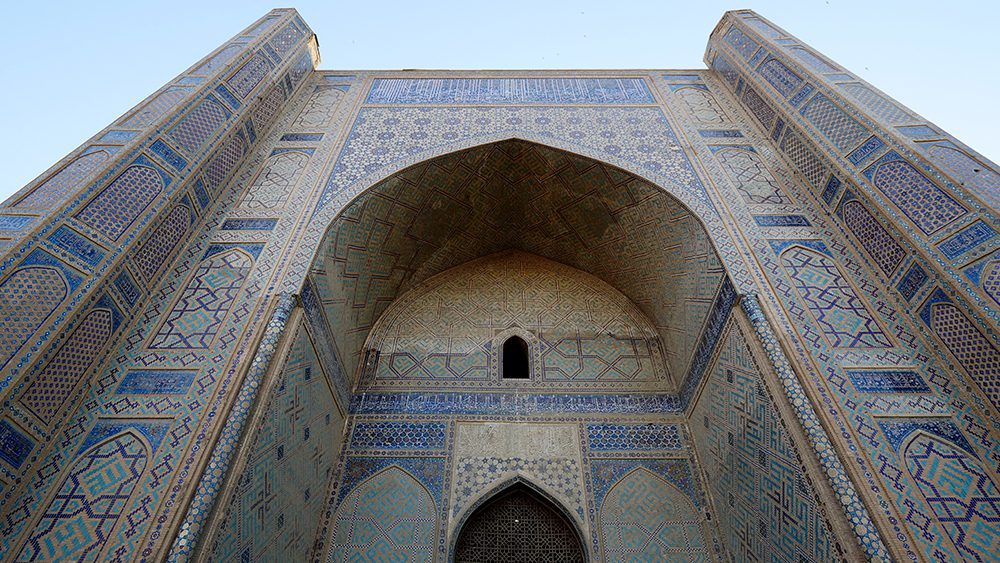
I personally loved the blue and white tilework and found Bibi-Khanym Mosque even more impressive than the one at Registan. The Arabic scripture on its walls and the level of craftsmanship needed to construct a building of this magnitude was truly awe-inspiring. It was one of my favorite things to see and do in Samarkand and I hope you’ll enjoy it as much as I did.
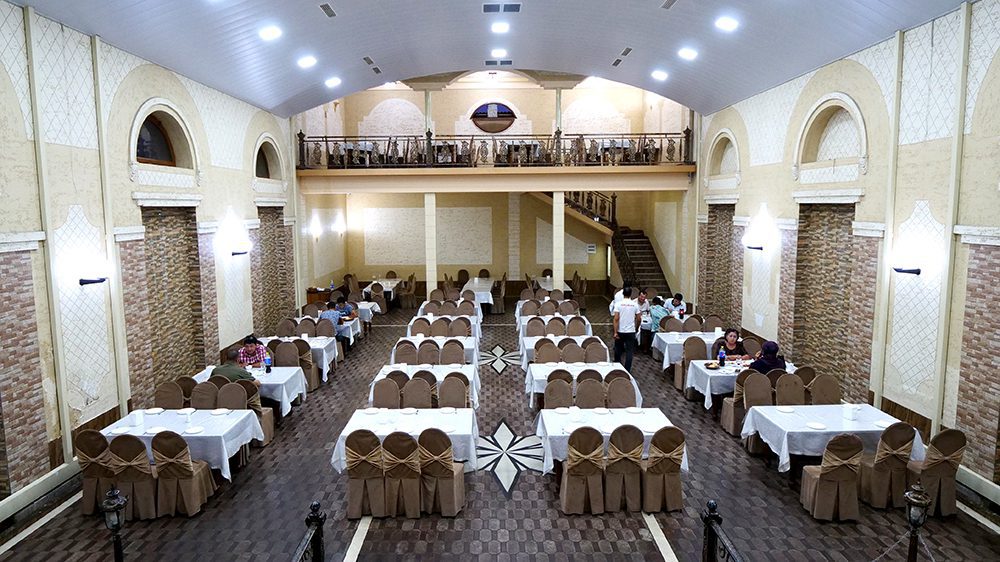
Samarkand is a fantastic city for foodies. There’s a lot of variety in the flavors and in the cuisine in general, and nowhere is that more apparent than at Ikrom Choyxonasi Restaurant. This popular eatery is Samarkand’s premier restaurant for kebabs, one of my favorite foods in the world. They make 22 different varieties at Ikrom Choyxonasi Restaurant, so carnivores of all types will find something on the menu that’s to their liking.
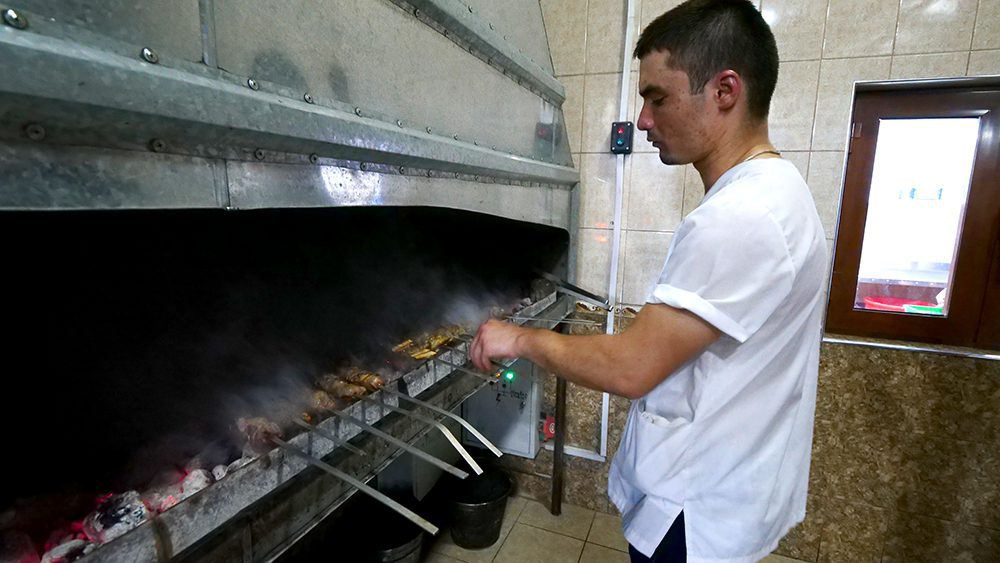
Before eating in the dining hall, I got the opportunity to go back to the kitchen and meet the cooks. I even got the chance to hold several uncooked kebabs in my hands just before they went on the grill!
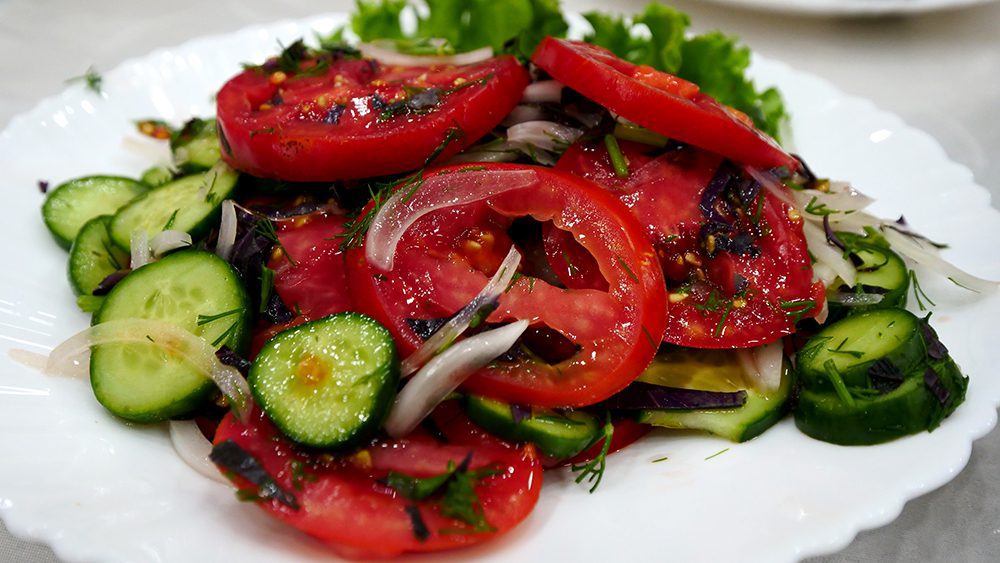
I started my meal with a delicious salad containing tomatoes, cucumber, onions, and mint. As I’ve mentioned before, there is nothing quite like an Uzbek tomato. They’re crispy, juicy, and so fresh. Eating these tomatoes is one of my favorite things to see and do in Samarkand.
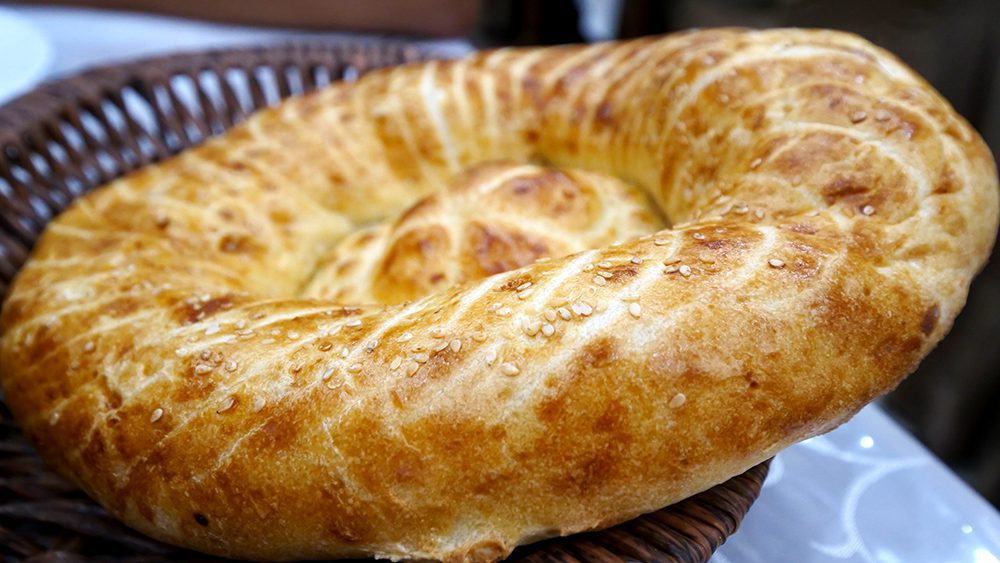
The tomatoes go especially well with the fluffy and freshly baked Uzbek bread that’s served as an appetizer. Eating the two together is almost like eating an Italian bruschetta! All of the food in Uzbekistan is farm to table, so freshness is one of the main hallmarks of the cuisine.
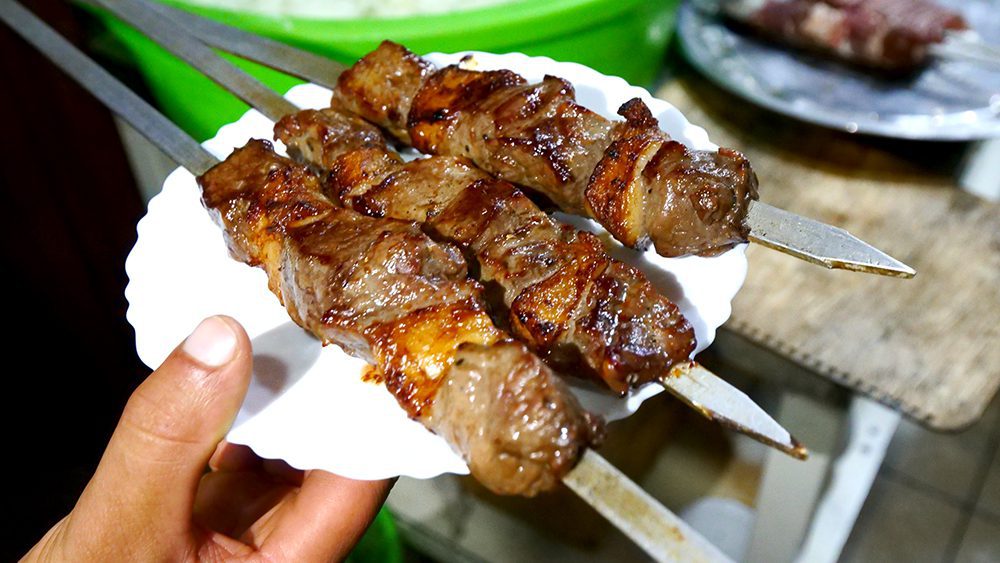
The kebabs are the star of the show at Ikrom Choyxonasi Restaurant, though. I ordered five different types: lamb, sheep, beef, chicken, and liver, as well as a lamb chop. The liver is dense, tasty, and surprisingly fatty. The fat added a pop of delicious flavor I wasn’t prepared for. I’m a liver aficionado and have eaten it all over the world, but this was some of the best liver I’d ever had in my life.
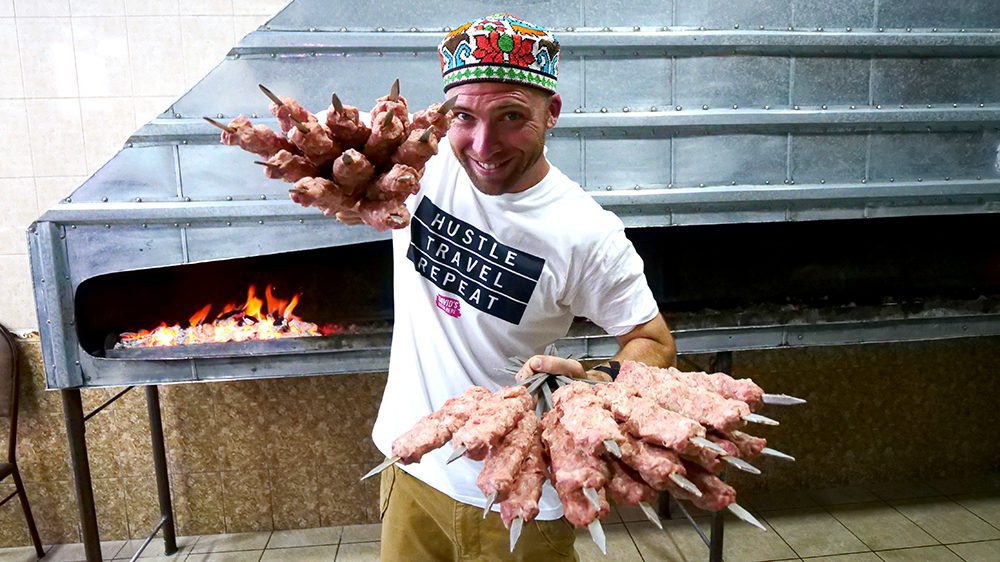
The beef kebab had a nice, flavorful layer of fat around it, which made the kebab extremely juicy. The beef had been mixed with bread, which gave it a really nice texture, and the meat had just the right amount of spices mixed throughout. It, along with the incredible lamb kebab, were both exceptional with the raw onions served on the side.
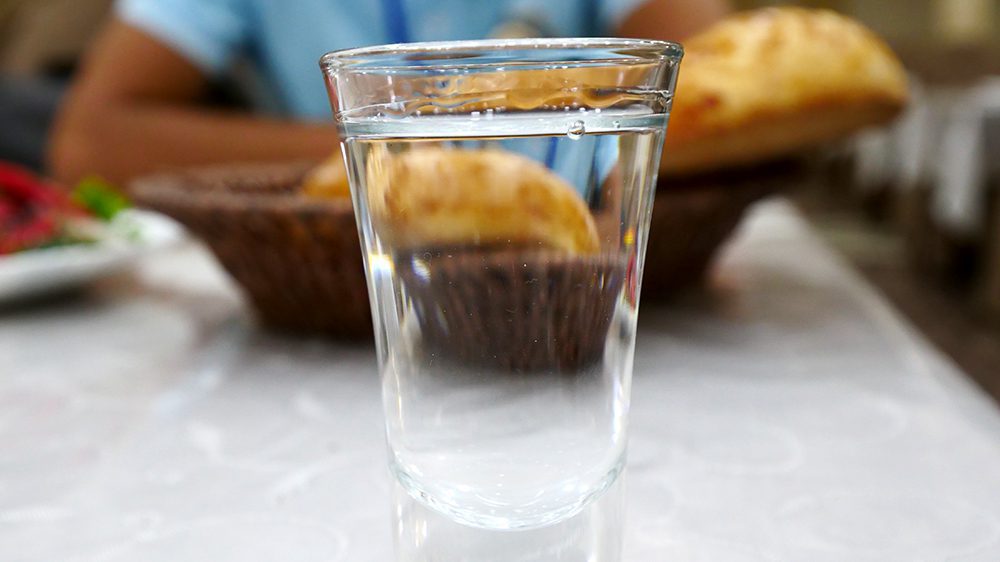
Speaking of lamb, every bite of the lamb chop was like an explosion of fat and flavor in my mouth. Eating the onions with it gave it a crunchy, refreshing element. The two were a marriage made in Uzbek gastronomical heaven! Always eat the lamb when you visit Uzbekistan. It’s certainly one of the best things to see and do in Samarkand!
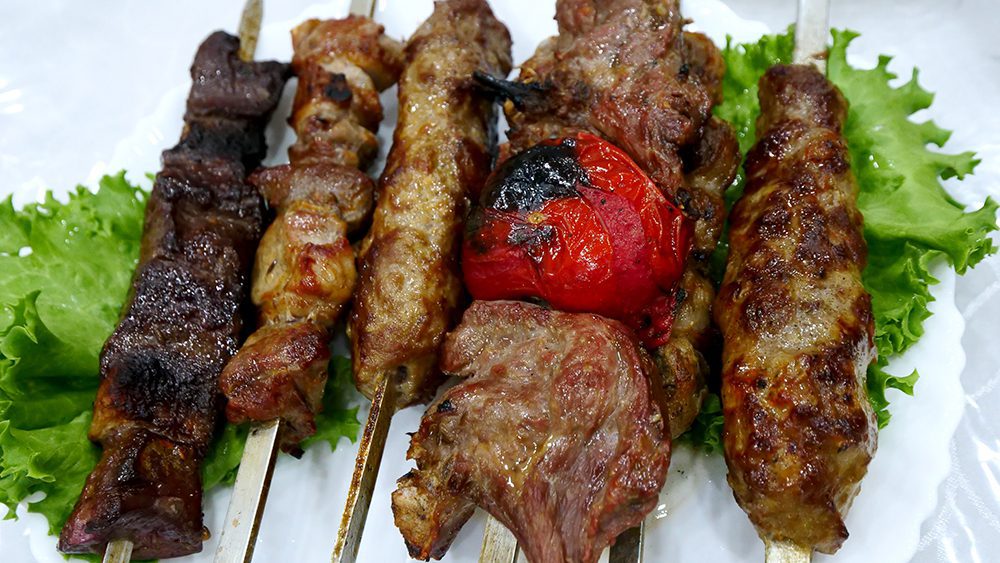
When in Uzbekistan, I highly recommend you try the vodka while you dine. The kind I was served at Ikrom Choyxonasi Restaurant was smooth and went down really easy. It definitely had me feeling nice by the end of the night!
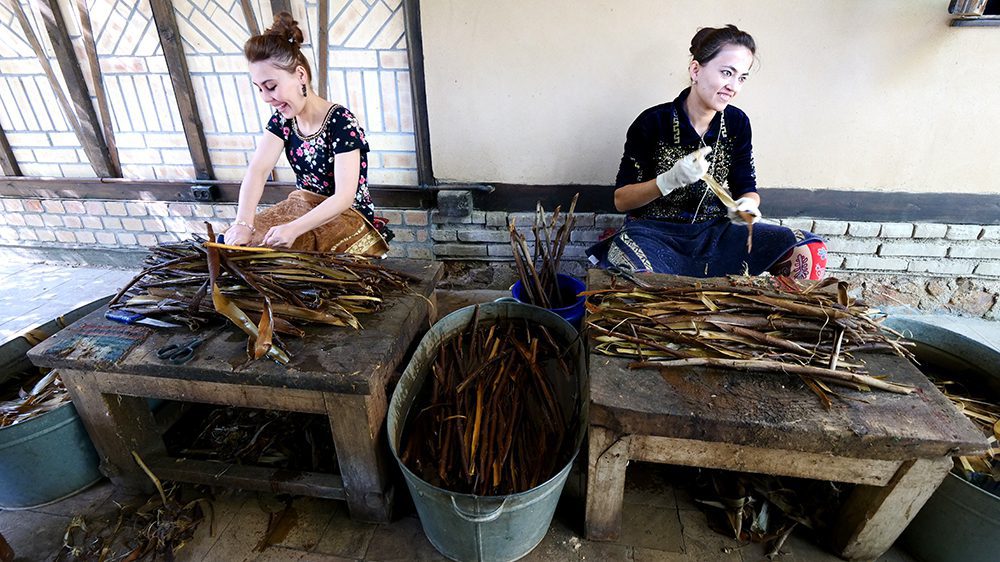
When I travel, I’ve always found it important to visit local workshops. Not only does it give me the opportunity to buy locally made crafts, it also gives me insight into traditions that often span centuries. One such tradition I implore you to learn about in Samarkand is the art of paper making, which you can explore by visiting a paper workshop.
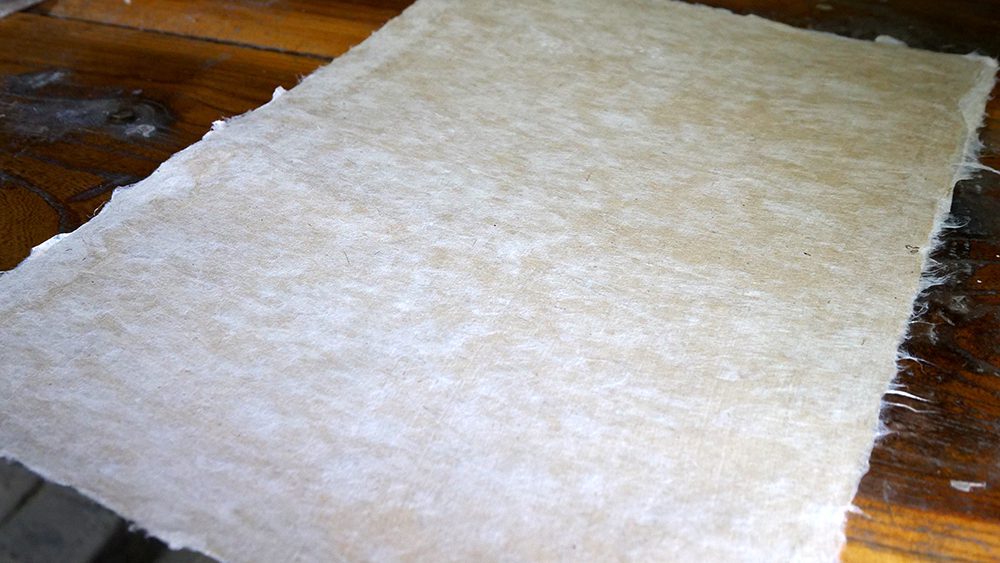
The workshop I visited looked like an unassuming old house with streams coursing through the property on the outside. But inside, it was a flurry of activity. They still make paper the ancient way here, and watching the process unfold was nothing short of mind-blowing.
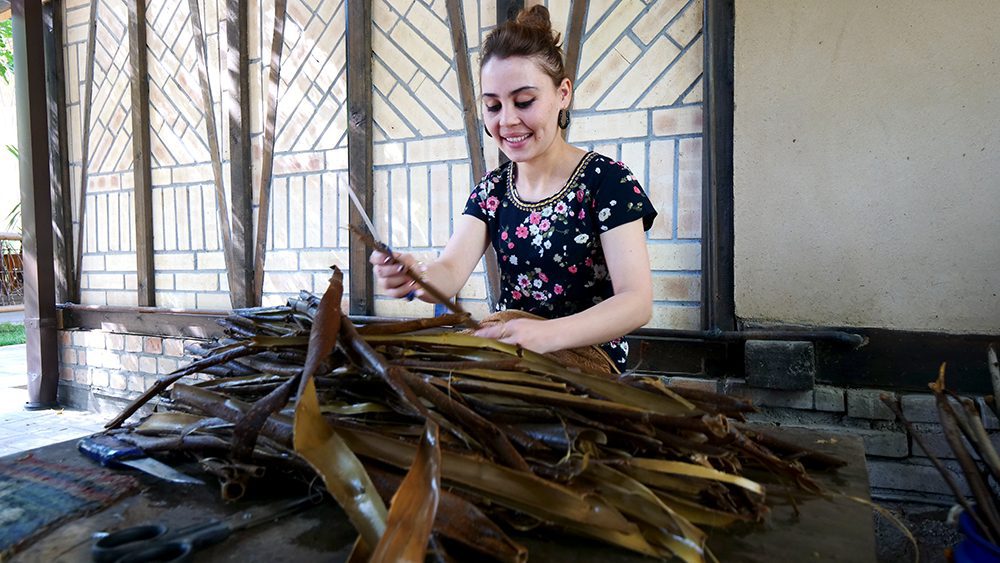
I watched as the female workers skinned tree branches and soaked the skin in buckets of water. They let them soak for three days and then boil it for five hours. The boiled skins are then taken to another room by a stream with a water wheel that’s connected to a floating, rotating long and an instrument in the room. This instrument pounds the boiled skins into sheets that are then pressed with a large rock for an entire day!
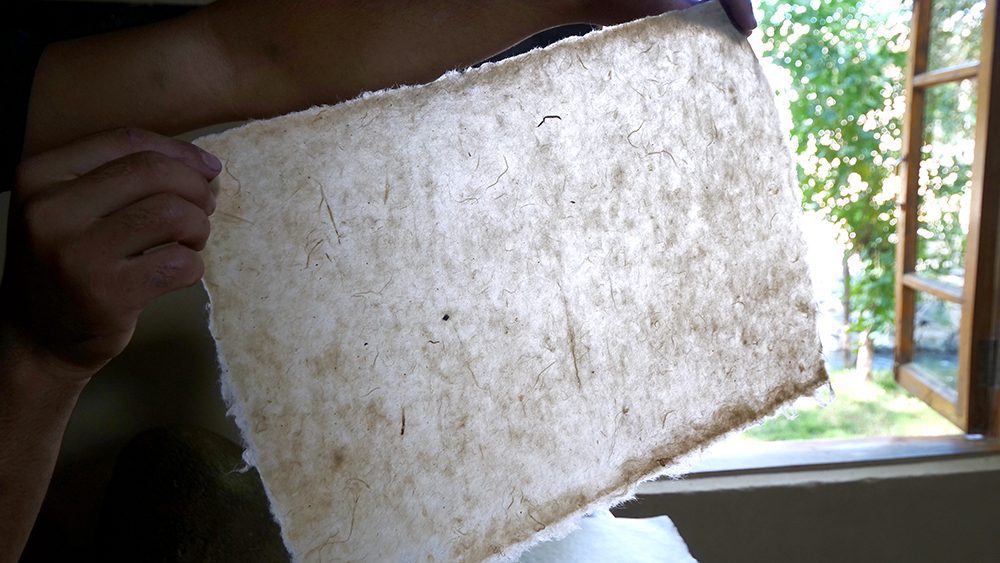
The paper is still not quite finished at this point in the process. The sheet is then put up so it can dry. In the summer, the drying process takes about 5 hours but in winter, it can take upwards of an entire day. After the sheet is dry, stray or straggly fibers are smoothed away by rubbing both sides with a stone for fifteen minutes each. At this point, you officially have paper!
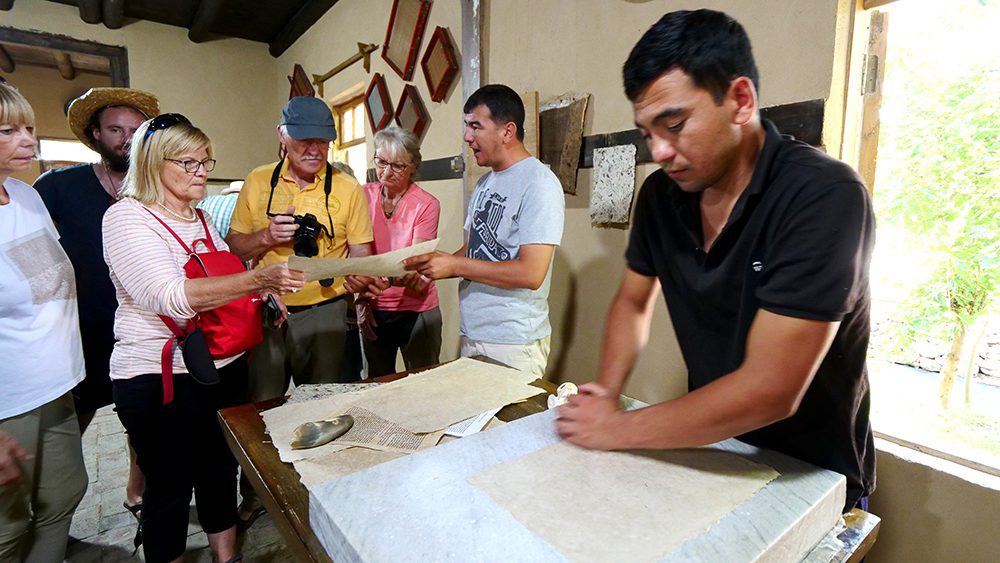
I tried my hand at smoothing a sheet of paper and quickly realized how intense the process is. My arms got tired quickly—well in advance of the 15-minute mark! I couldn’t help but respect the craftsmen and women who continue to make paper the traditional way. Then, I learned how they use the paper and my admiration level for them and the work they do went up tenfold!
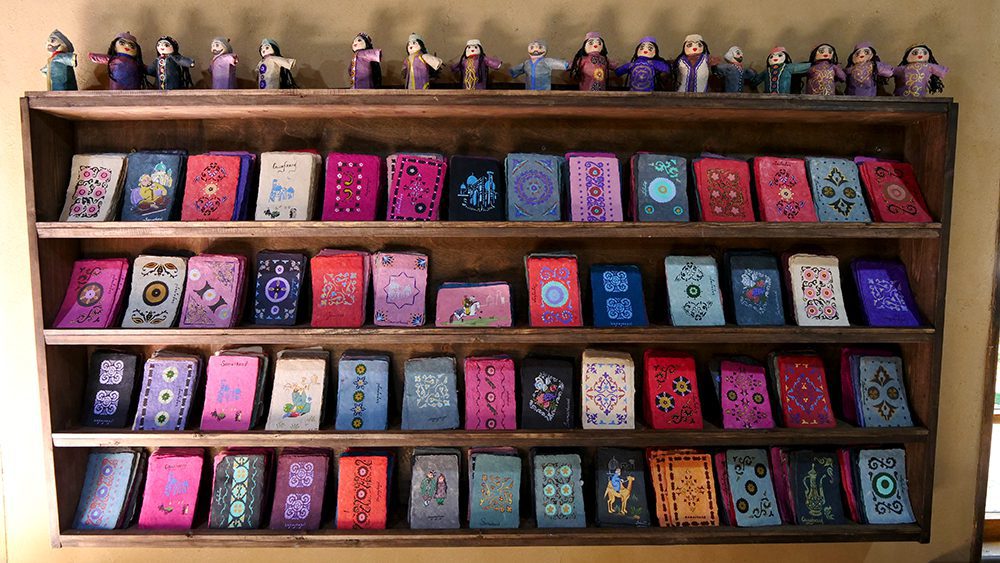
The paper that is produced is then used in a number of other crafts. It’s used to make hats, dolls, purses, clothing, and my favorite: masks. By this point in my trip, I had been in Uzbekistan for several days. However, I had yet to come across a mask until then.

I collect masks from each country I visit and display them on my wall at home. So, finding these beautiful, traditional masks was a wonderful stroke of luck! They normally cost 400,000 som ($42.06 USD) each, but because I bought three, I negotiated down to 350,000 som ($36.79 USD) each. They were well worth the purchase and are among my favorite souvenirs from Uzbekistan!
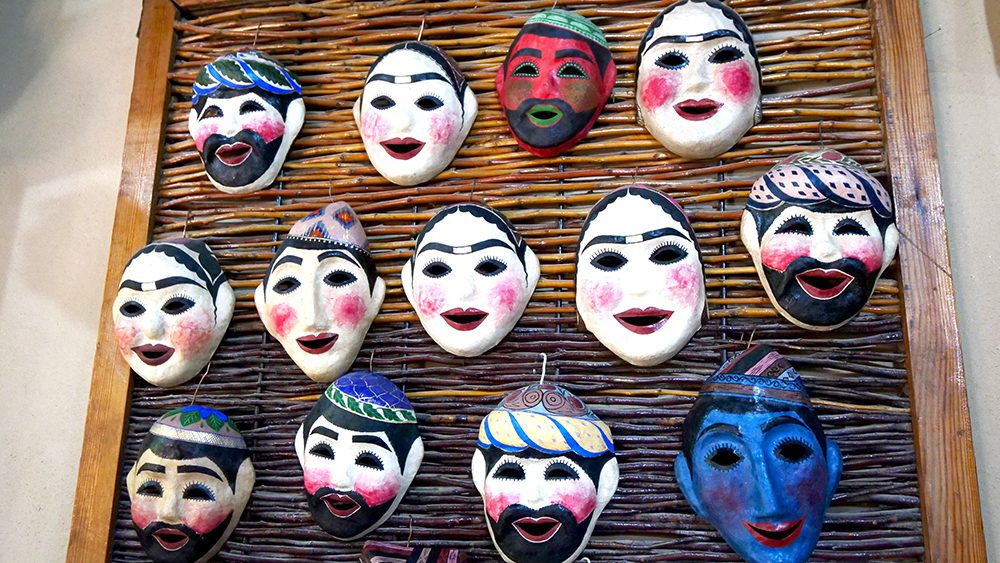
If you want to learn about the ancient art of papermaking, this place is easily one of the best things to see and do in Samarkand! Just remember that, like most places around the country, you’ll have to pay in cash. They don’t take credit cards here!
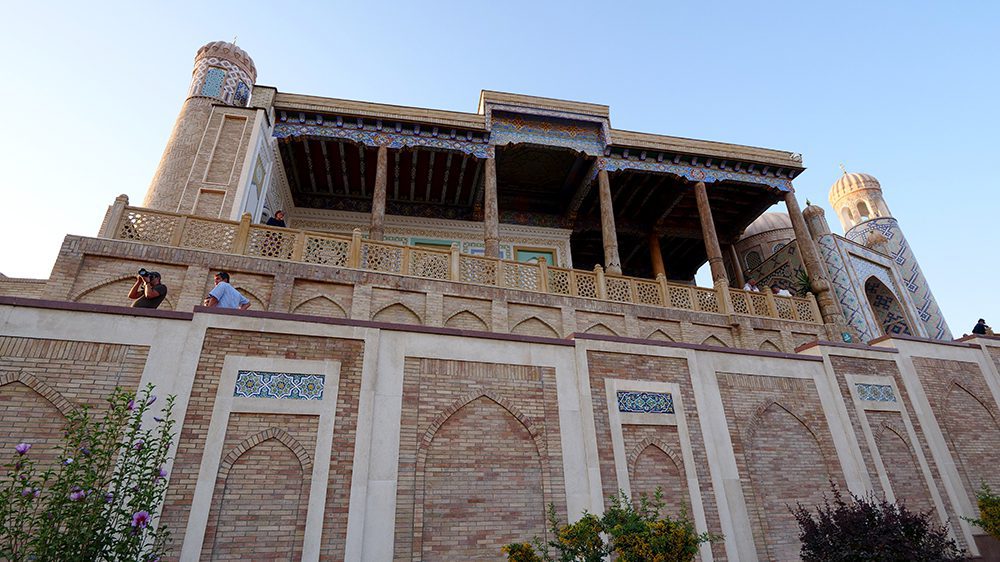
As sundown approached after my visit to Bibi-Khanym Mosque, my guide decided to take me to a lookout point where you can get stunning views over Samarkand. Along the way, we made a quick stop at the Islam Karimov Mausoleum, the final resting place of Uzbekistan’s first president, Islam Karimov.
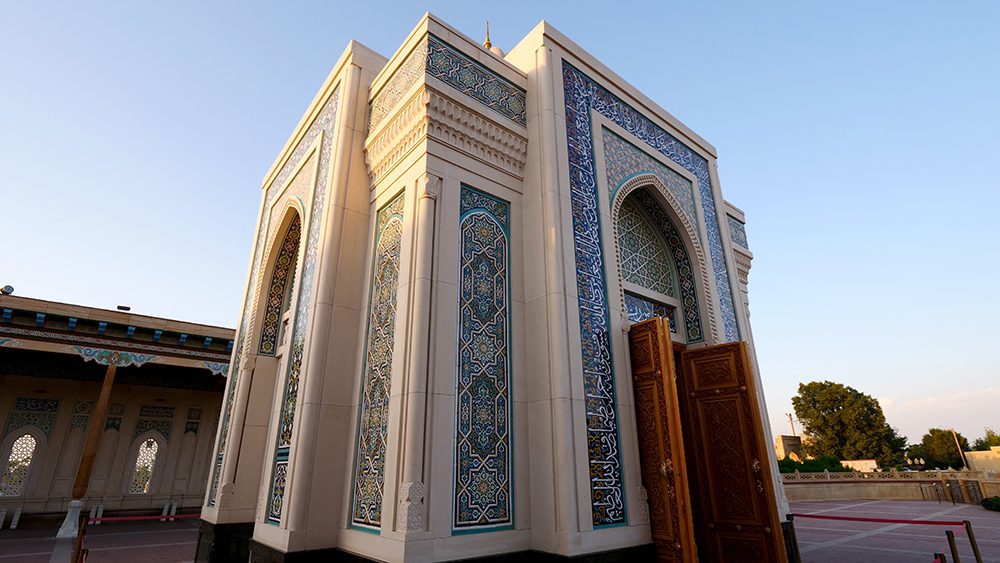
The mausoleum, which opened to the public on January 30, 2018, stands among the buildings of the Hazrati Khizr Mosque Complex. Uzbekistan’s best builders and craftsmen were brought in to help construct the mausoleum, which follows in the traditions of Uzbek architecture.
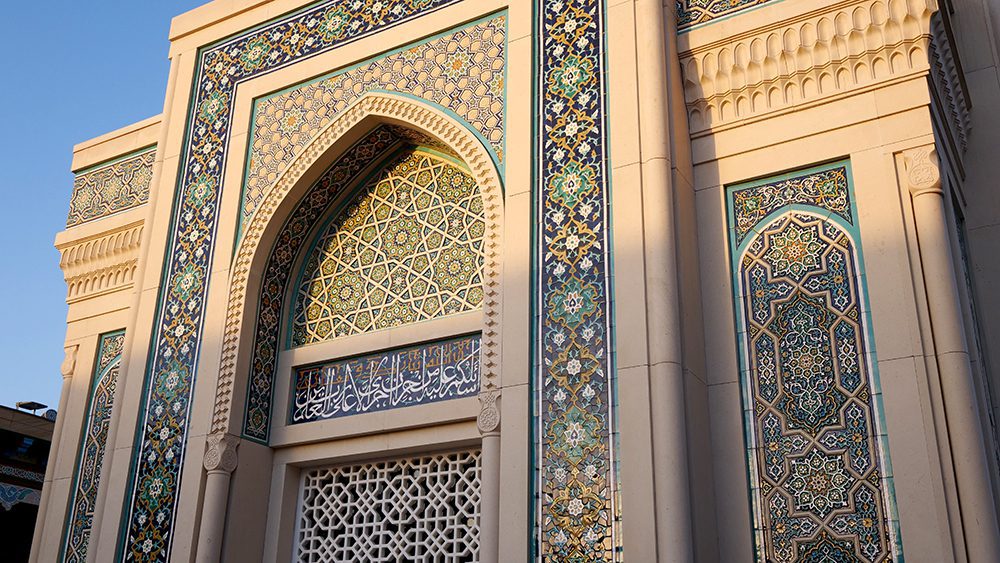
The mausoleum itself is decorated with gilding, precious stones, and green onyx. Karimov’s tombstone is fitting for a man of his stature and is made of gleaming white onyx.
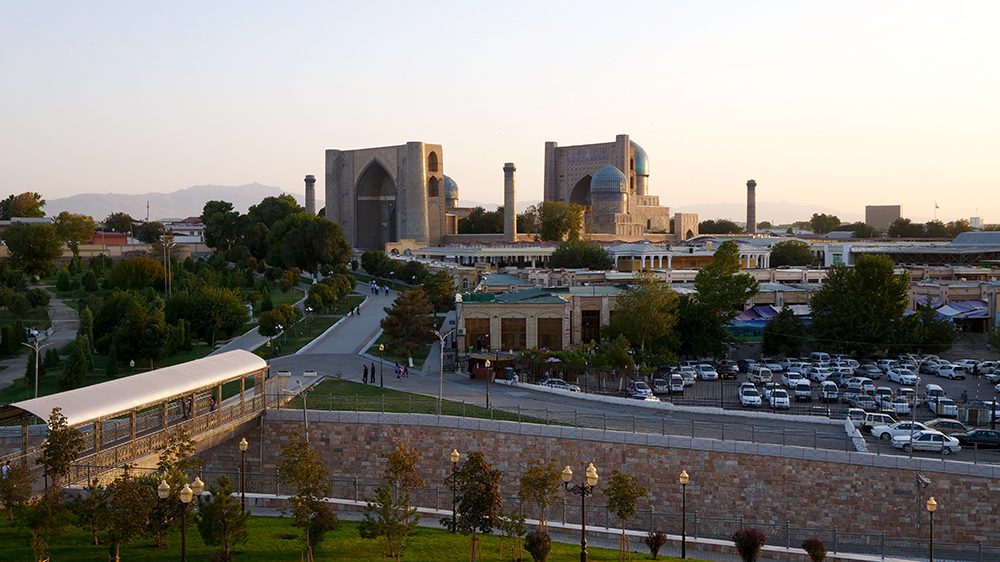
At the Mosque complex’s entrance, a message embossed on a marble slab reads, “This is a sacred and eternal place where the First President of the Republic of Uzbekistan, the great statesman and politician, the respectable and honorable son of Uzbek people Islom Karimov rests.”
You can’t film or take photos inside, but trust me. Visiting the resting place of Uzbekistan’s first president is among the best things to see and do in Samarkand.
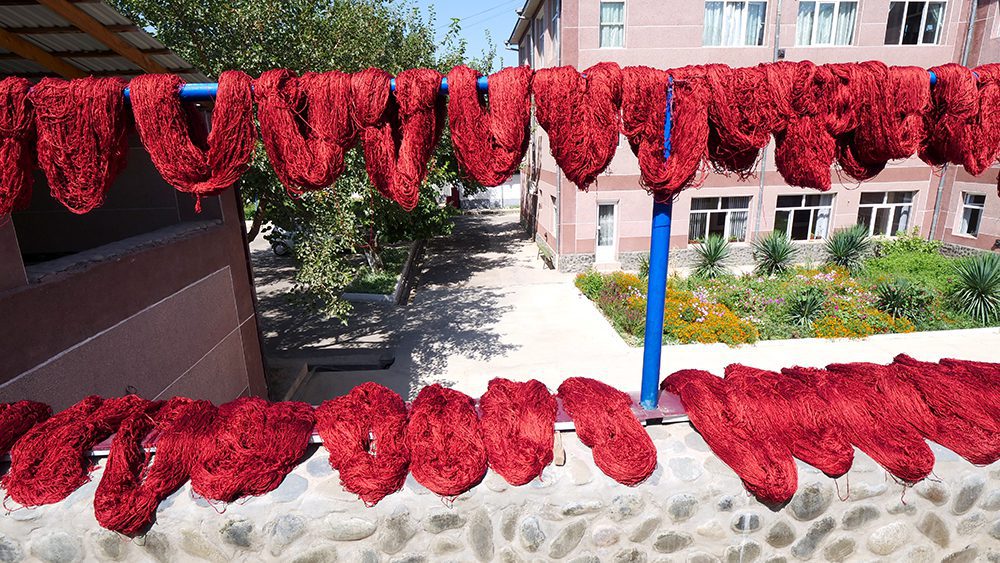
The art of carpet-making is an ancient, traditional practice in Uzbekistan. During the heyday of the Silk Road, Uzbek silk carpets were among the most popular items to buy. Hundreds of years later, these gorgeous, woven creations are still every bit as breathtaking as they were when Marco Polo passed through the city in the 13th century. The best way to learn about this art form in Samarkand is to visit a silk workshop.
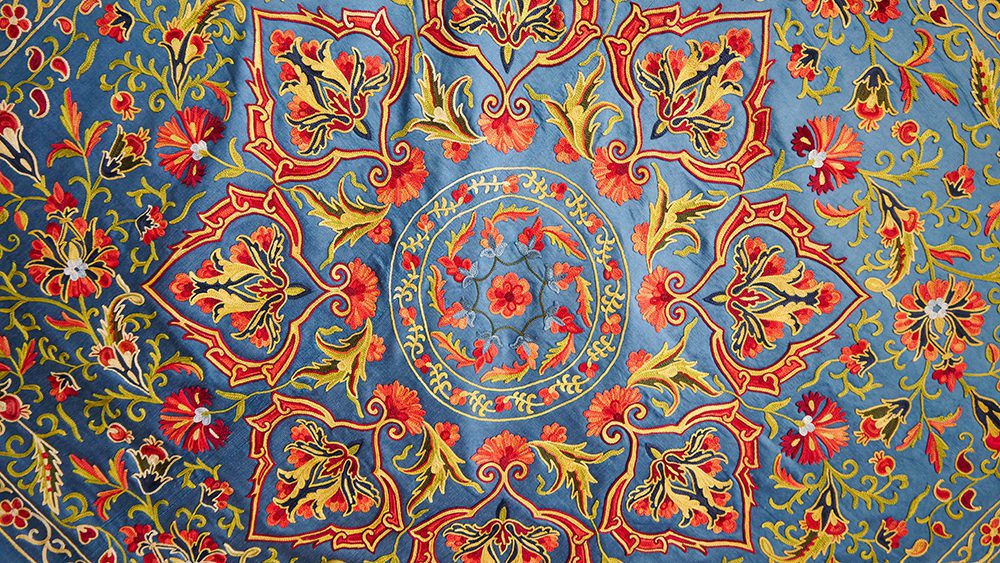
During my time at a local silk workshop, I learned they employ eighty female weavers. The beautiful carpets they had woven over the years were prominently displayed on the walls of the workshop. The craftsmanship was unbelievable and made me even more excited to see the work that goes into making the carpets.
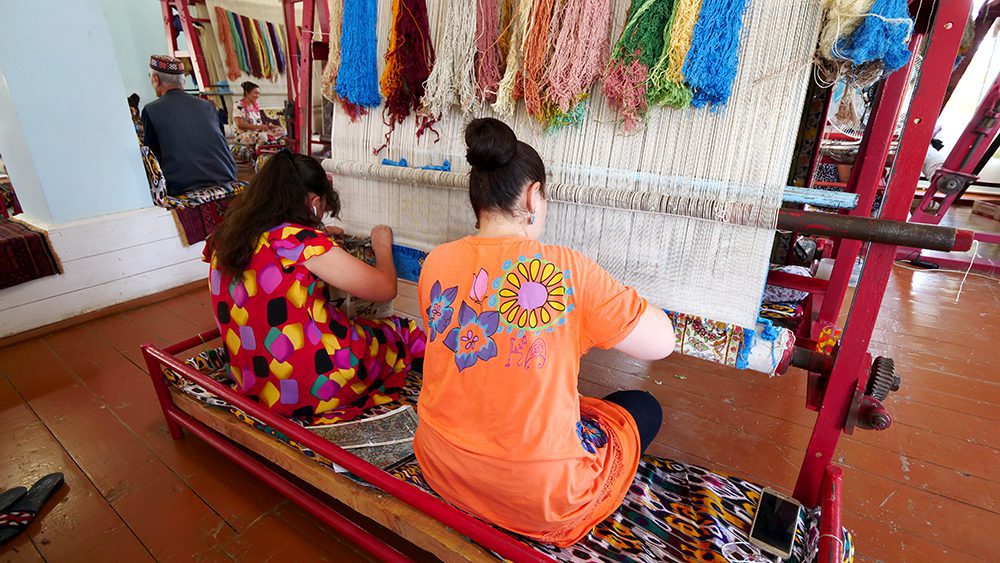
The work that goes into weaving one carpet is painstaking to say the least. Just one carpet can take months to complete. The women work from 9 a.m. to 5 p.m. every day. They use a number of colored silk yarns, which get their color from natural vegetable dyes. The dyes used come from plant materials like flowers, roots, and pomegranate skin.
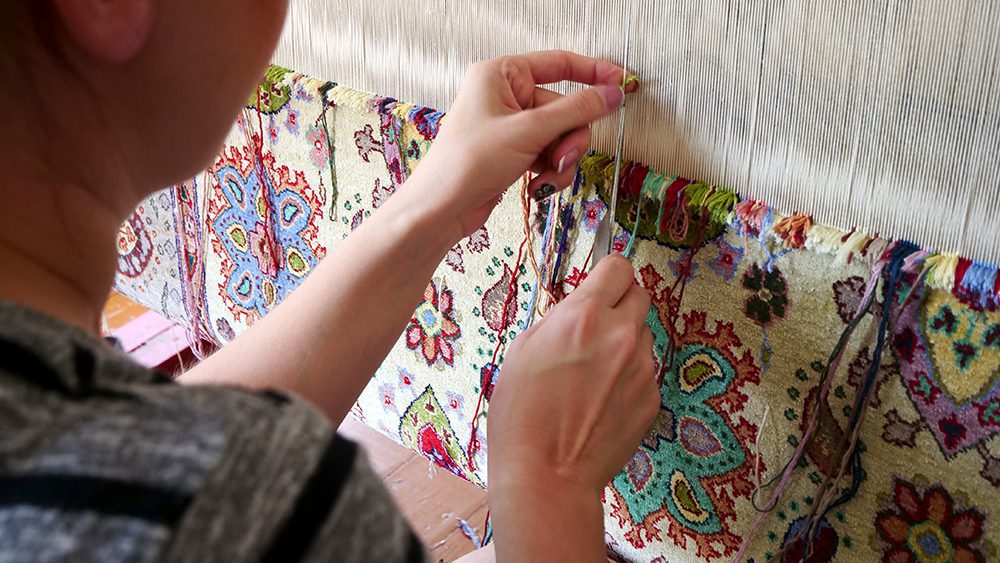
Another thing that I found really interesting is that the weavers don’t switch up their designs. They only use traditional patterns, which have special meanings. The weavers have to know which colors go where as they’re creating the carpets. It’s amazing to see how fast their fingers fly across the looms they use! Watching them work is, without question, among the top things to see and do in Samarkand.
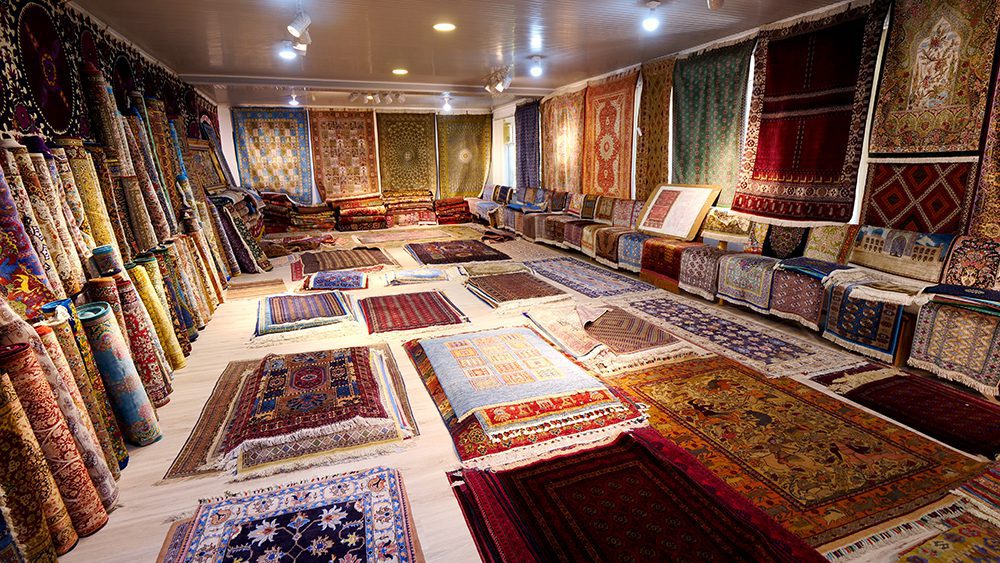
The workshop I visited is the largest silk factory in Central Asia. Not surprisingly, the showroom displaying all of the carpets available for sale was a massive, cavernous room with hundreds of carpets as far as the eye could see. The carpets come in many sizes and range from $80 USD to well over $1,000 USD.
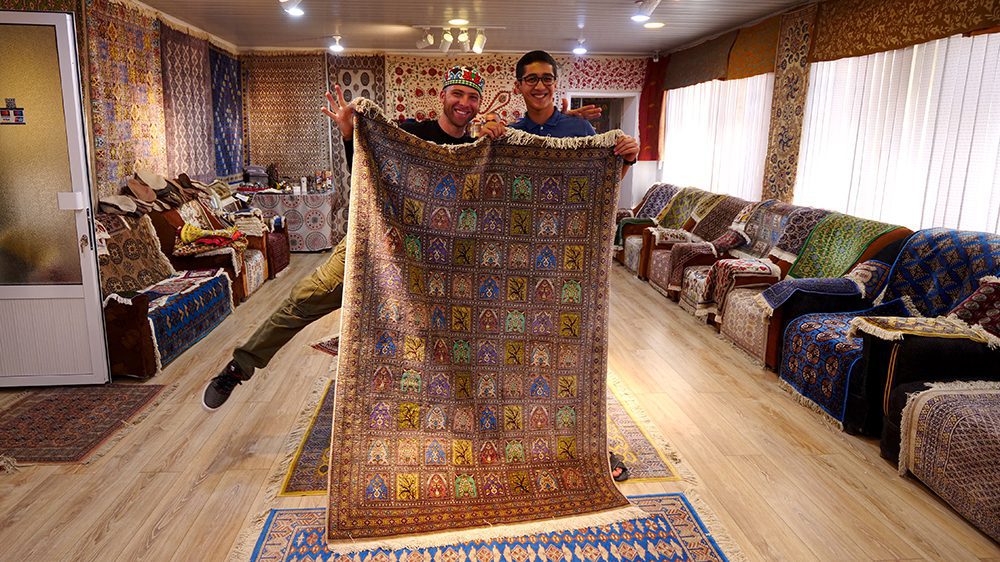
Even if you don’t have the money to take home an authentic Uzbek carpet, I suggest visiting to see the work these women do. Seeing them exhibit the amount of patience it takes to make one carpet makes me respect them even more than I already did.
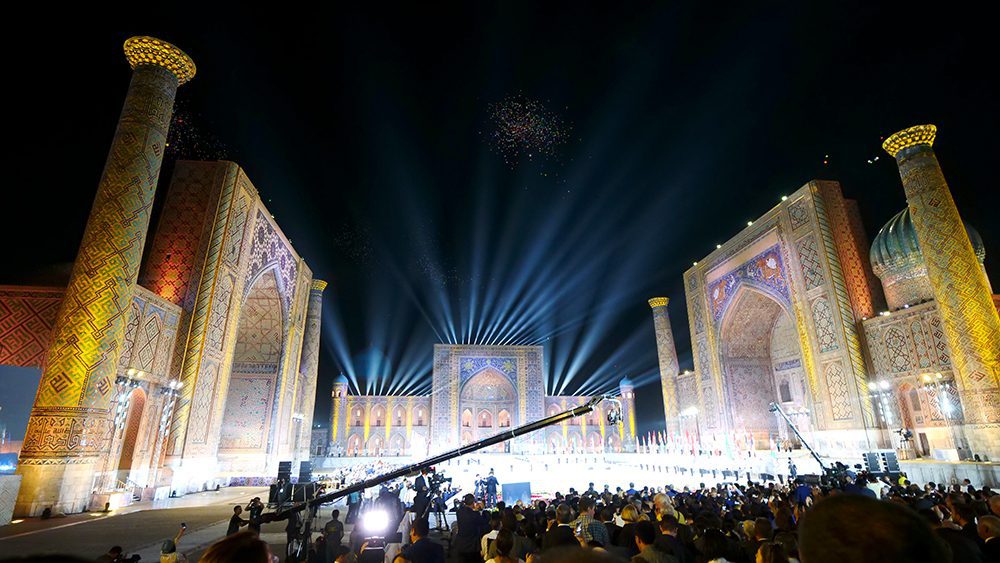
One of my favorite things to see and do in Samarkand is to attend the Sharq Taronalari International Music Festival. This incredible celebration is one of the largest music and cultural festivals in all of Central Asia. It takes place every two years in Registan Square and brings together amazing singers, dancers, and musicians from all over the world.
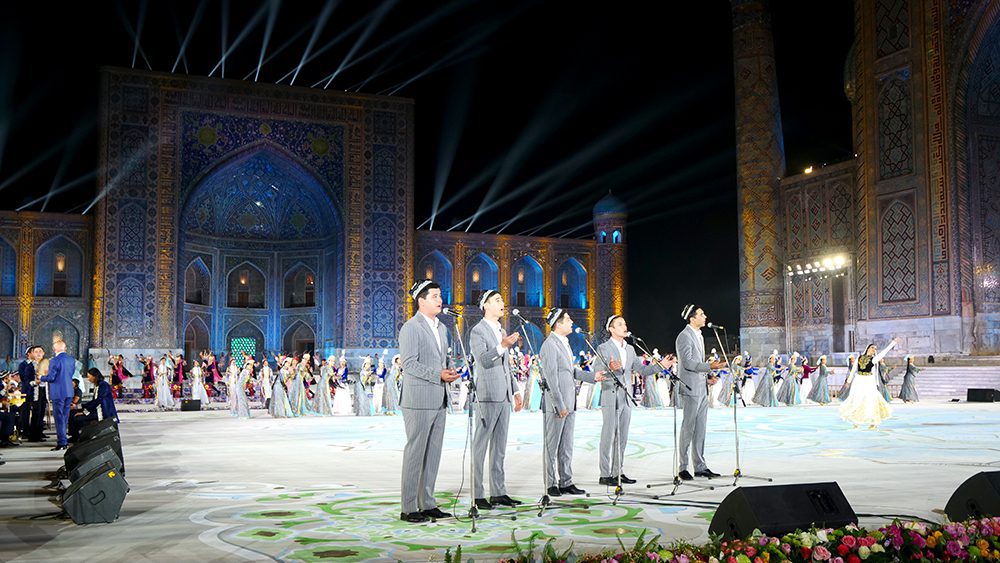
Sharq Taronalari’s name is fitting, as it translates to “melodies of the East.” The week-long festival features exhibitions of Uzbek clothing and musical instruments, as well as conferences for the participants, festival guests, and the media. I had the wonderful opportunity to attend a concert during the festival. I even got to meet the President of Uzbekistan, who gave a speech before the night’s festivities began!
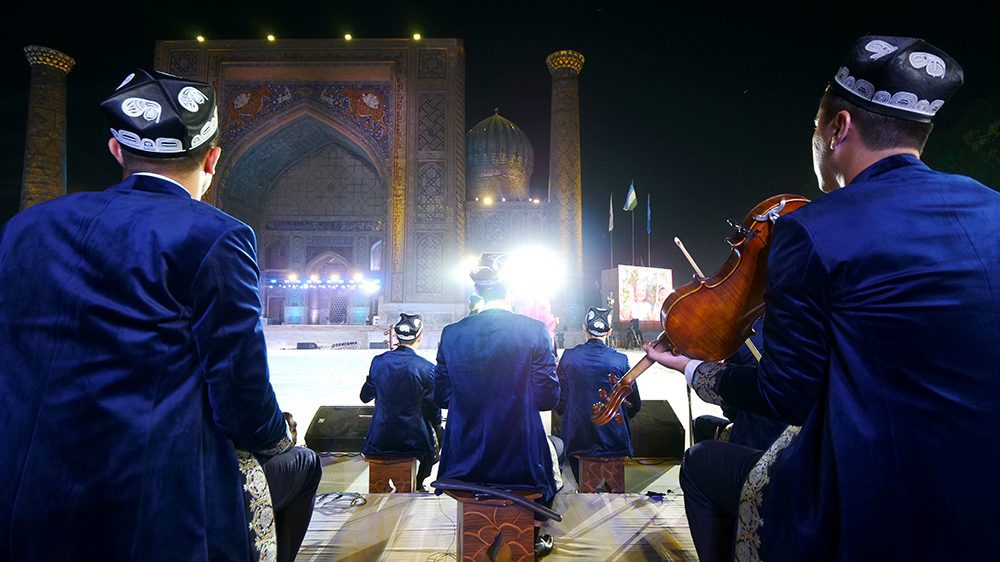
The concert itself was an unbelievable display of cultural unity. The music was amazing! It was such a pleasure to watch the costumed dancers perform in the shadow of the madrasahs. There were Uzbek media outlets at the festival as well. I even got interviewed by some of them during the performances!
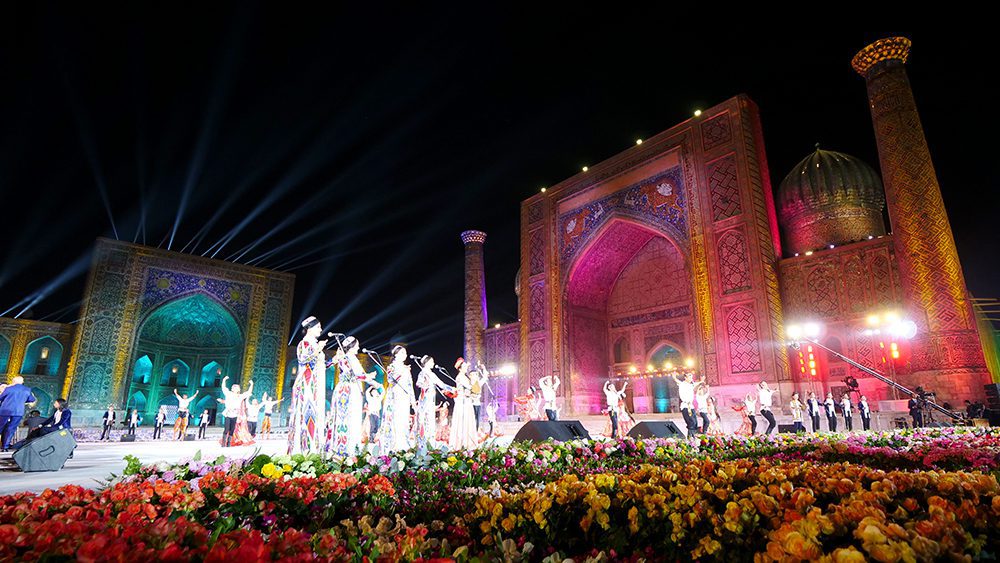
If you can make it to Uzbekistan in August of any odd-numbered year, the Sharq Taronalari International Music Festival is among the top things to see and do in Samarkand. It was a magnificent night I will remember for the rest of my life. It’s something I implore everyone to experience.

If you’re looking to travel to multiple cities in Uzbekistan, you can always fly. Or, if you’d prefer to see more of the country, you can take the country’s Afrosiyob high-speed train. The rail line connects the capital city of Tashkent with Samarkand. As of August 25, 2016, the route includes a stop in Bukhara.
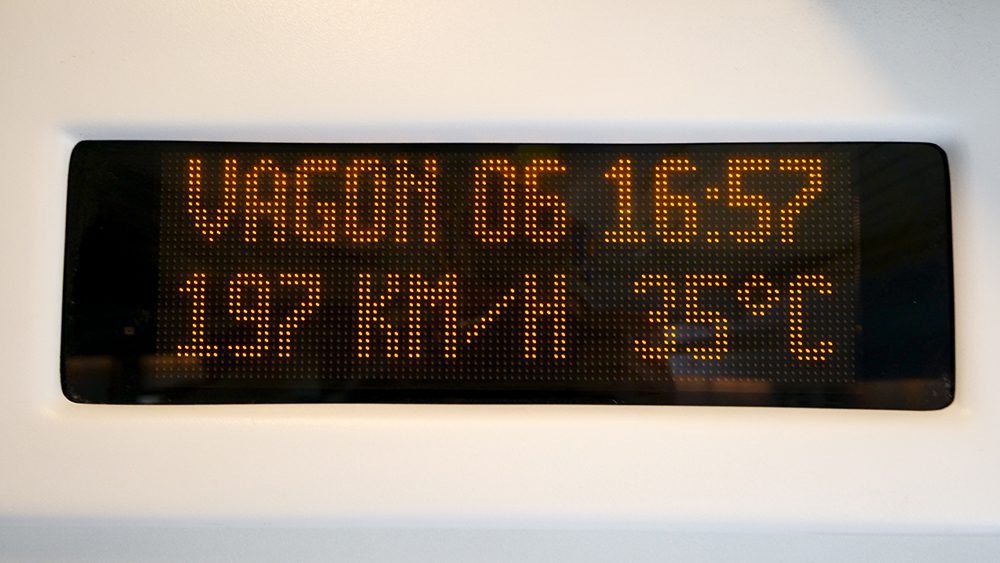
The train runs seven days a week. It consists of four different types of carriages: VIP, business class, economy class, and bistro. The two VIP carriages contain eleven seats each. Meanwhile, 26 passengers can ride in each of the two business class carriages. There are four economy-class carriages, with 36 seats in each of them. Each train also contains a bistro carriage, which is a restaurant car.
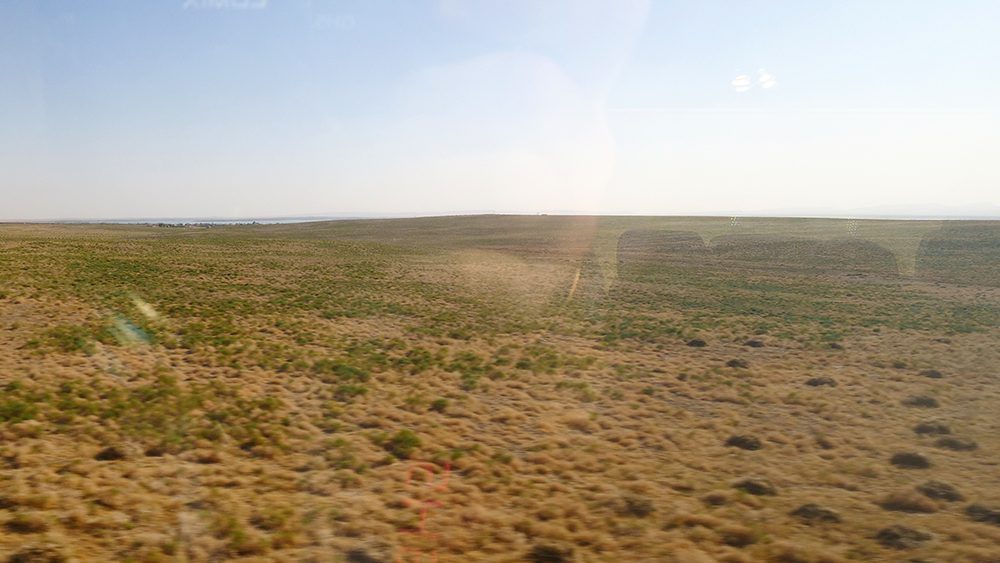
A ride from Samarkand to Bukhara takes roughly 90 minutes. I rode between the two cities with my fellow travel content creators from the World Influencers Congress and had a wonderful time. The trains are modern, clean, and non-smoking, with comfortable seating, air conditioning, and convenient tables. It’s a fun way to travel with friends and is one of my favorite things to see and do in Samarkand. Take a ride and see for yourself!
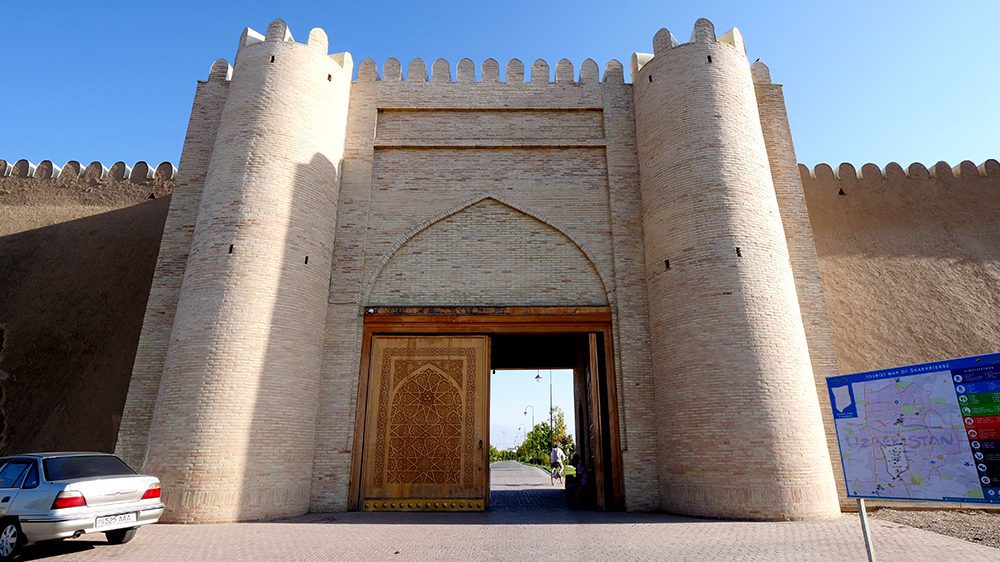
One of my favorite things to see and do in Samarkand is to take a road trip! Just 90 minutes south of Samarkand is the UNESCO World Heritage City of Shahrisabz. You’ll have to take a winding road through agricultural land and mountainous terrain to get there, but the views you’ll be greeted with on the ride are spectacular.

Shahrisabz is best known as the birthplace of Amir Timur. Though Timur lived in the 14th century, his enduring legacy is apparent in sites throughout the city. A statue dedicated to him stands proudly inside the city’s walls. Visitors can also learn about him and artifacts found in the area at the Shahrisabz Museum of History and Material Culture. The museum was founded in 1996 on the 660th anniversary of Timur’s birth.
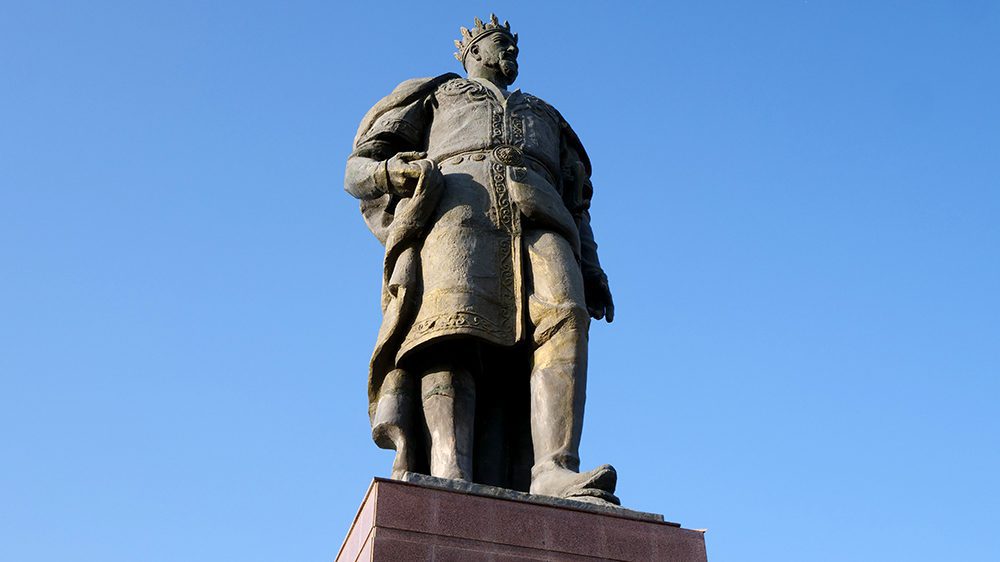
Unlike many of Timur’s relatives, who were buried in Samarkand, his eldest and favorite son was buried in Shahrisabz. Most of the sites I visited in Shahrisabz were quite grand and beautiful. However, Timur’s son’s burial place, the Tomb of Jehangir, was quite plain.
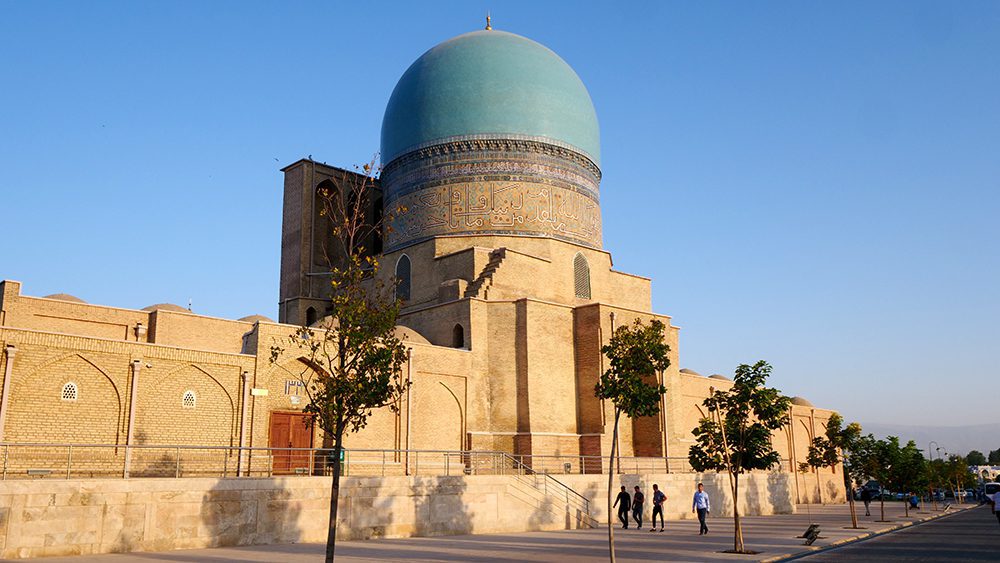
Other notable sites in Shahrisabz include the imposing but partially destroyed OQ Saroy Majmuasi Complex and the magnificent Kok Gumbaz Mosque. Both sites are adorned with intricate, vivid tilework that has withstood the elements and time itself. It’s a beautiful reminder of just how grand these monuments were in their heyday.
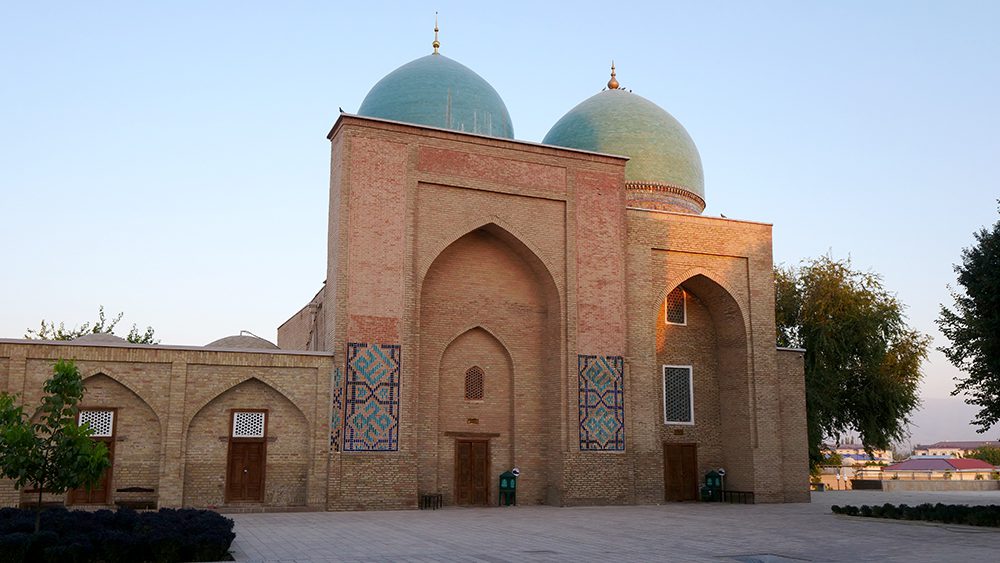
To learn more about the things you should do in Shahrisabz, please check out my full Shahrisabz travel guide!
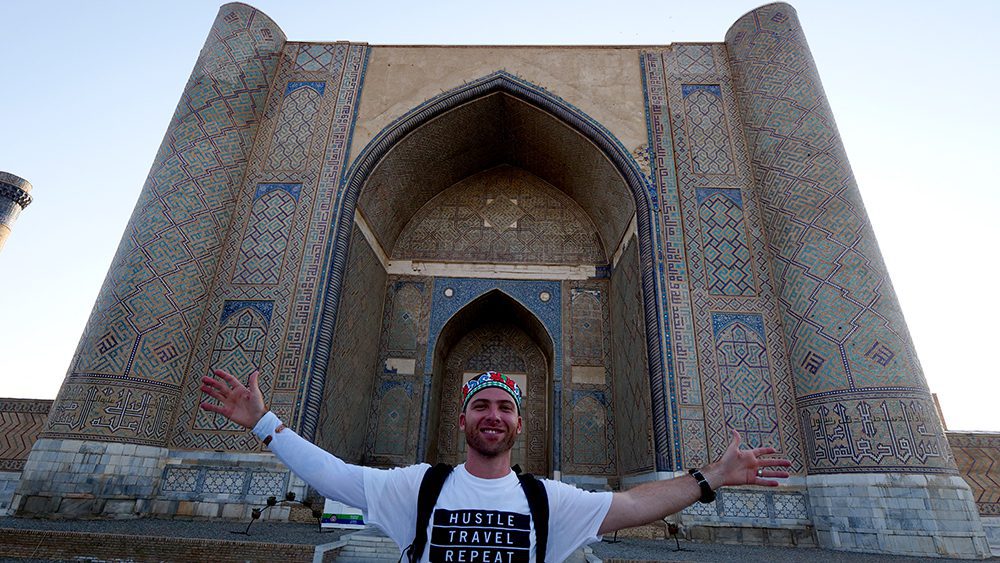
From its gorgeous necropolis complex to its incredible craft workshops, it is impossible to visit Samarkand and not feel its history. Likewise, its mosques and bazaars are the perfect showcases for how the culture here has endured through the ages. Add in the delicious traditional food served in its restaurants and you have an ancient city that is akin to a living museum, preserving the ways of the past so they are not forgotten by future generations. This place is too special for words and I hope you get to experience it for yourself someday. Book a trip to Uzbekistan today to explore the top things to see and do in Samarkand like I did!
NOTE: If you need to check the visa requirements of a particular country, click here. To apply for a visa, find up-to-date visa information for different countries, and calculate the cost of a particular visa, click here!
Counter
101 Countries • 1432 Cities